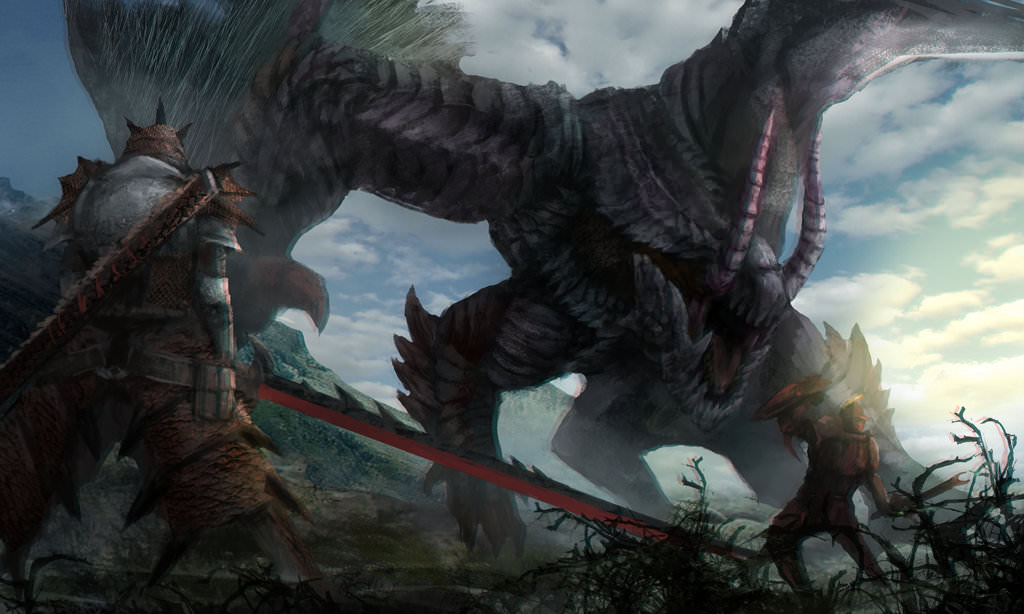
& Monstrosities
Table of Contents
-
Brute Wyverns
- 2Barroth (CR 4)
- 3Uragaan (CR 6)
- 4Anjanath (CR 7)
- 5Duramboros (CR 9)
- 6Radobaan (CR 10)
- 7Glavenus (CR 13)
- 8Brachydios (CR 17)
- 9Deviljho (CR 18)
-
Fanged Wyverns
- 10Zinogre (CR 10)
- 11Jagras (CR 1/2)
- 11Great Jagras (CR 4)
- 12Girros (CR 1)
- 12Great Girros (CR 6)
- 13Dodogama (CR 7)
- 13Shamos (CR 1)
- 14Tobi-Kadachi (CR 6)
- 15Odogaron (CR 8)
-
Unknown
- 19Gore Magala (CR 21)
- 20Shagaru Magala (CR 25)
- 22Leshen (CR 12)
- 23Ancient Leshen (CR 21)
-
Virus
- 17Frenzy Virus
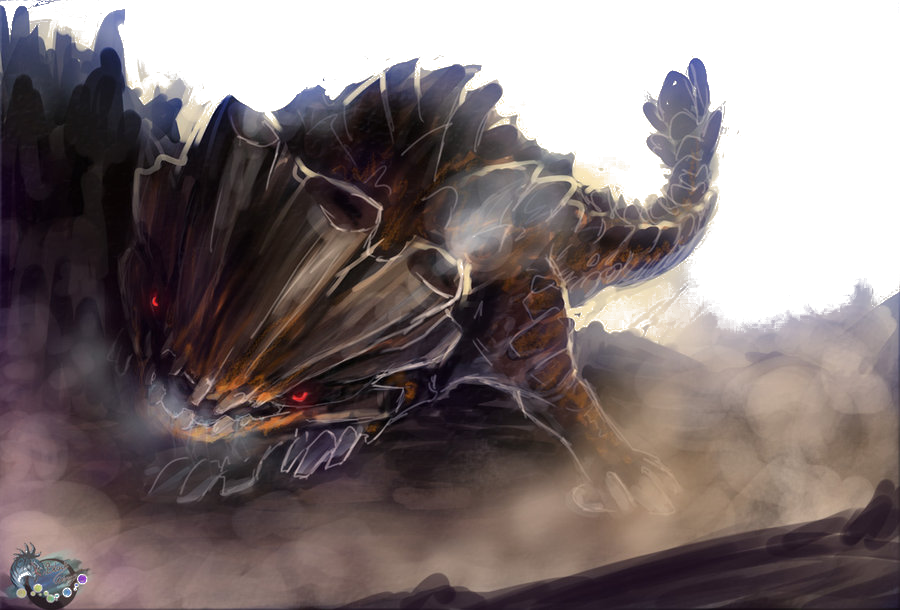
Brute Wyverns
Brute Wyverns are considered to be Wyverns that are adapted to complete life on land, even sometimes being called Theropods from greatly resembling some predatory dinosaurs. These monsters are typically large, bipedal theropods, that are prone to living in areas abundant in food sources. Brute Wyverns exhibit a wide variety of dietary habits; some are strictly herbivorous or carnivorous, while others subsist on insects or even minerals. These monsters often use their heavy, muscular bodies to charge blindly through an environment to damage attackers or prey, and include many defensive adaptations, including tail clubs, horns, and even hammer-like chins and fists. Brute Wyverns can be found in almost any type of environment.
Barroth
Barroth is a large, bipedal monster characteristic of the Brute Wyvern class. It is noted for the large crown structure atop its skull, which houses its nostrils. Its body is covered in rigid plates of armored hide that help protect it from the harsh desert environment. Barroth possesses a pair of small red eyes and a mouthful of long, peg-shaped teeth.
Barroth is capable of using its heavy head as a plow to smash through the environment, as well as cause damage to any living thing caught in its way. Because its nostrils are located on top of its head, Barroth can completely submerge itself in the cool mud during the scorching desert days.
It will occasionally roll in dirt and mud, possibly to cool off from the hot desert sun. Although docile by default, Barroth becomes extremely territorial when disturbed. It will release an initial warning roar. If that fails, it will continuously attack until the threat is exterminated. An insectivore, it is known to attack Altaroth nests in order to feast on the occupants inside.
Barroth is uniquely adapted to a desert lifestyle, and as such can almost exclusively be found in such regions, although it has been known to wander into the woods occasionally.
Barroth
Large wyvern (brute), unaligned
- Armor Class 16 (Natural Armor)
- Hit Points 95 (10d10 + 40)
- Speed 40 ft.
STR DEX CON INT WIS CHA 16 (+3) 12 (+1) 18 (+4) 6 (-2) 6 (-2) 4 (-3)
- Skills Perception +0
- Senses passive Perception 10
- Languages -
- Challenge 4 (1,100 XP)
Actions
Multiattack. The barroth makes two attacks: one headbutt and one stomp.
Stomp. Melee Weapon Attack: +5 to hit, reach 5 ft., one target. Hit 11 (2d6 + 4) bludgeoning damage.
HeadButt. Melee Weapon Attack: +5 to hit, reach 5 ft., one target. Hit 13 (2d8 + 4) bludgeoning damage.
Wallow. The barroth wallows in mud, covering itself in a thick layer, which grants the barroth +2 AC for 1 minute or until it takes 15 damage from a single attack.
Shake. While the barroth is covered in mud it may use its action shake chunks of mud free from its body landing in a 10-foot radius around him. Each creature in that area must make a DC 14 Dexterity saving throw or become restrained by the mud. As an action, the restrained target can make a DC 13 Strength check, bursting from the mud on a success. The mud can also be attacked and destroyed (AC 10; hp 5)
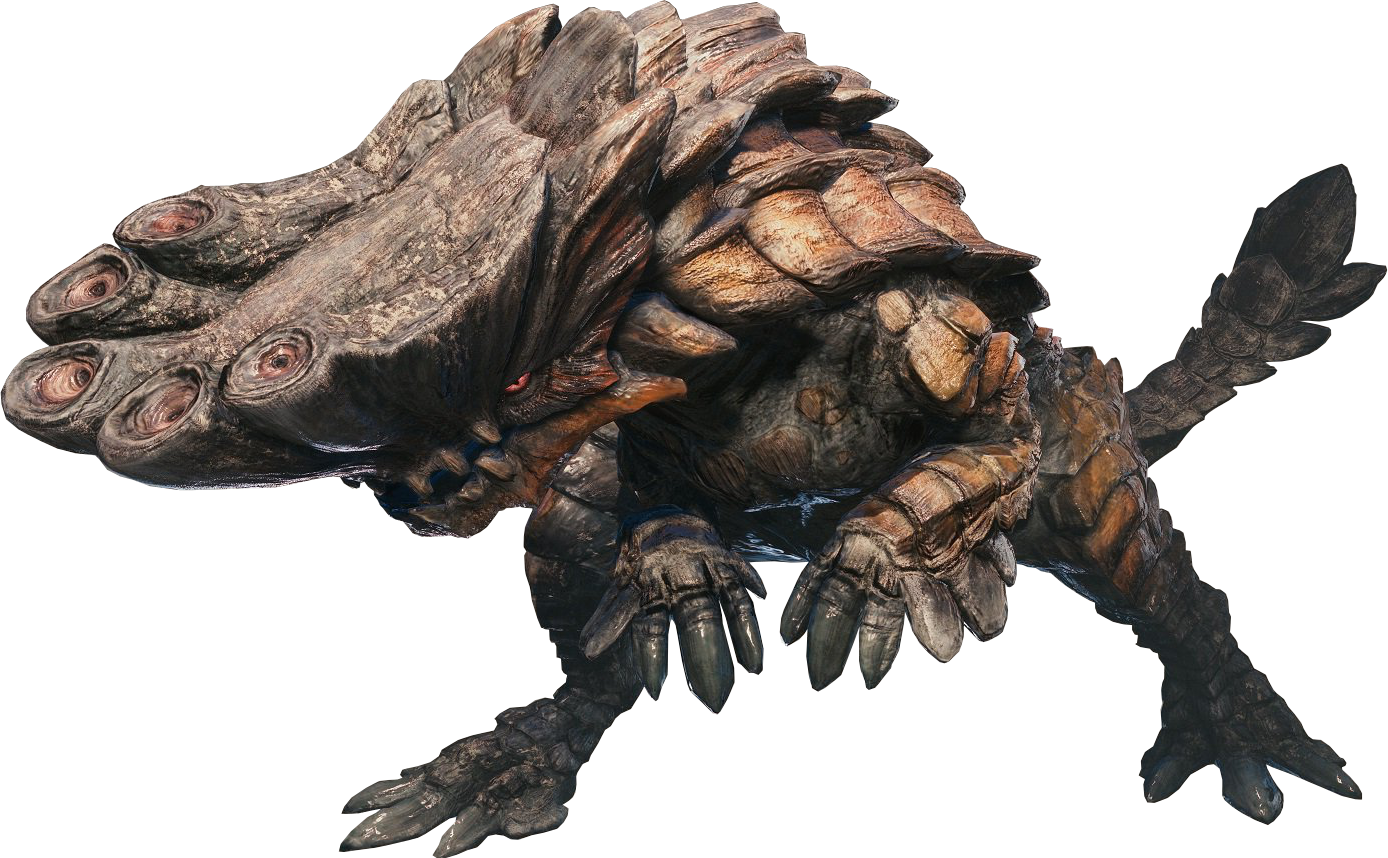
Uragaan
Huge wyvern (brute), unaligned
- Armor Class 15 (Natural Armor)
- Hit Points 123 (13d12 + 39)
- Speed 40 ft.
STR DEX CON INT WIS CHA 19 (+4) 10 (+0) 16 (+3) 5 (-3) 12 (+1) 6 (-2)
- Skills Perception +4
- Senses passive Perception 14
- Languages -
- Challenge 6 (2,300 XP)
Actions
Multiattack. The uragaan makes one Tail attack and two Chin Slam attacks.
Tail. Melee Weapon Attack: +7 to hit, reach 5 ft., one target. Hit 20 (3d10 + 4) bludgeoning damage.
Chin Slam. Melee Weapon Attack: +7 to hit, reach 5 ft., one target. Hit 17 (3d8 + 4) bludgeoning damage.
Roll (recharge 5-6). The uragaan rolls its body into a wheel and moves up to its speed, during this move it may move through other creatures without provoking opportunity attacks . Any creatures the Uragaan moves through must succeed on a DC 15 Dexterity saving throw or take 28 (8d6) bludgeoning damage and be knocked prone.
Emit Flames. (2/per Long rest). The uragaan releases a wave of fire from its underside in a 10-foot radius around it. Each creature in that area must make a DC 14 Dexterity saving throw, taking 21 (6d6) fire damage and catches fire on a failed save or half as much on a successful one and does not catch fire. Until someone takes an action to douse the fire, the creature takes 3 (1d6) fire damage at the start of each of its turns.
Uragaan
Uragaan is covered in a lustrous gold-colored hide. Its back is lined with hard crystals and its chin is plated with a rock-like shell, suggesting the Uragaan has evolved a tough exterior due to life in volcanic regions. Its underbelly is covered in a sticky, tar-like substance which it uses to affix explosive rocks to itself.
Uragaan's signature ability is to roll its body into a wheel to increase its speed and agility. The growths on their back stable this rolling ability. It will do this often in an attempt to crush the adventurer. Uragaan create a very effective weapon in the form of its chin by melting minerals and attaching them with lava, which it can use for breaking up rocks. The chin also evens its center of gravity so its legs can compensate for its heavy body. In a group of Uragaan, the one with the largest chin has the highest status among the group.
Uragaan is something of oddity in the food chain - it has almost no natural predators, but is not particularly predatory itself and has no competitors, preferring to consume vast amounts of plants and rock. The rocks that it feeds on are surprisingly nutrient rich, and its rock-hard lower jaw is perfectly designed to break them up, although it does make them awkward to swallow.
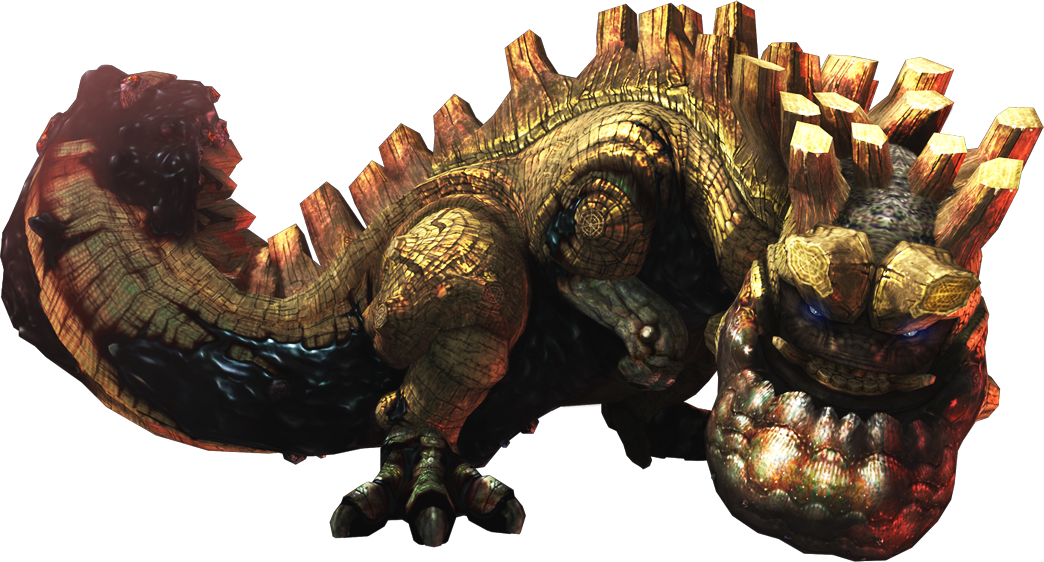
Anjanath
Anjanath has a pink face, somewhat resembling a Vulture, along with pink scales covering its underbelly. Its hind legs are powerful and muscular, while its front limbs are much smaller and mostly useless. Black proto-feathers cover Anjanath's back, front limbs, and legs, which give it an appearance similar to the most recent depictions of some theropod dinosaurs like T-rex.
Anjanath has powerful jaws that allow it to rip apart foes, along with a powerful nose used for smelling out prey. It also has the ability to breath fire from its maw.
Anjanath are relentless predators that will chase down anything that dares attack them. Once they've been provoked, Anjanath won't let an enemy get away easily. They are known to leave behind a mucus-like substance in order to marks its territory.
Anjanath
Huge wyvern (brute), unaligned
- Armor Class 14 (Natural Armor)
- Hit Points 136 (13d12 + 52)
- Speed 40 ft.
STR DEX CON INT WIS CHA 23 (+6) 10 (+0) 19 (+4) 2 (-4) 12 (+1) 9 (-1)
- Skills Perception +4
- Senses passive Perception 14
- Languages -
- Challenge 7 (2,900 XP)
Keen Smell The anjanath has advantage on Wisdom (Perception) checks that rely on smell.
Actions
Multiattack. The anjanath makes two attacks: one with its bite and one with its tail. It can't make both attacks against the same target.
Tail. Melee Weapon Attack: +9 to hit, reach 10 ft., one target. Hit 22 (3d10 + 6) bludgeoning damage.
Bite. Melee Weapon Attack: +9 to hit, reach 10 ft., one target. Hit: 25 (3d12 + 6) piercing damage plus 5 (1d10) fire damage. If the target is a Medium or smaller creature, it is Grappled (escape DC 17). Until this grapple ends, the target is Restrained, and the anjanath can't bite another target.
Firebreath (recharge 5-6). The anjanath exhales fire in a 60-foot line that is 5 ft. wide. Each creature in that line must make a DC 17 Dexterity saving throw, taking 27 (5d10) fire damage on a failed save, or half as much damage on a successful one.
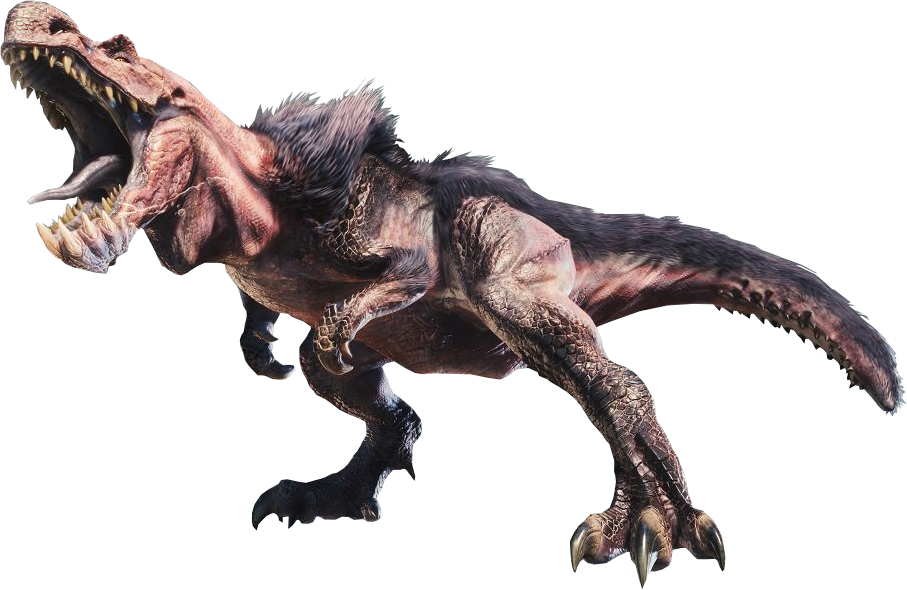
Duramboros
Huge wyvern (brute), unaligned
- Armor Class 16 (Natural Armor)
- Hit Points 149 (13d12 + 65)
- Speed 40 ft.
STR DEX CON INT WIS CHA 24 (+7) 12 (+1) 21 (+5) 3 (-4) 10 (+0) 6 (-2)
- Damage Resistances piercing from nonmagical weapons
- Senses passive Perception 10
- Languages -
- Challenge 9 (5,000 XP)
High Jump. The duramboros high jump is up to 20 feet, without a running start. In addition, the duramboros does not incur attacks of opportunity while jumping.
Jump Attack. If the duramboros jumps 20 feet straight up and makes at tail attack against a target within range. On a Hit, each creature within 5 feet of the target must make a DC 19 Dexterity saving throw or take the same damage as the target on a failed save, or half as much on a successful one.
Actions
Multiattack. The duramboros makes two attacks: one with its Horn attack and one Tail attack. It can't make both attacks against the same target.
Tail. Melee Weapon Attack: +11 to hit, reach 10 ft., one target. Hit 26 (3d12 + 7) bludgeoning damage.
Horn. Melee Weapon Attack: +11 to hit, reach 10 ft., one target. Hit: 23 (3d10 + 7) piercing damage.
Duramboros
Duramboros is a bulky, heavyset, bovine monster with stocky, muscular legs and a thick upper body. It features a very thick outer hide that is riddled with heavy folds, with a row of armored plates running along its back and tail. Duramboros' most distinctive features include its massive tail club, twin brow horns, and a pair of energy-rich dorsal humps. Duramboros' slow lifestyle often results in a layer of moss and algae growing upon its hide, most noticeably along the back.
Duramboros is a herbivore, subsisting primarily on fallen tree trunks. Using its ram-like pair of horns, as well its hammer-like tail club, it is known to push or knock down weak or dead trees in order to comfortably feed on them. Though generally docile, Duramboros has a capacity for aggression if provoked. It is known to use its tail club, horns, and overall mass to attack foes. One of its most unique tendencies is to twirl in place, using its tail club as a counter-balance to build up momentum, allowing it to hurl itself at an attacker and crush them with its body.
Due to its diet, Duramboros is most commonly encountered in highly forested areas.
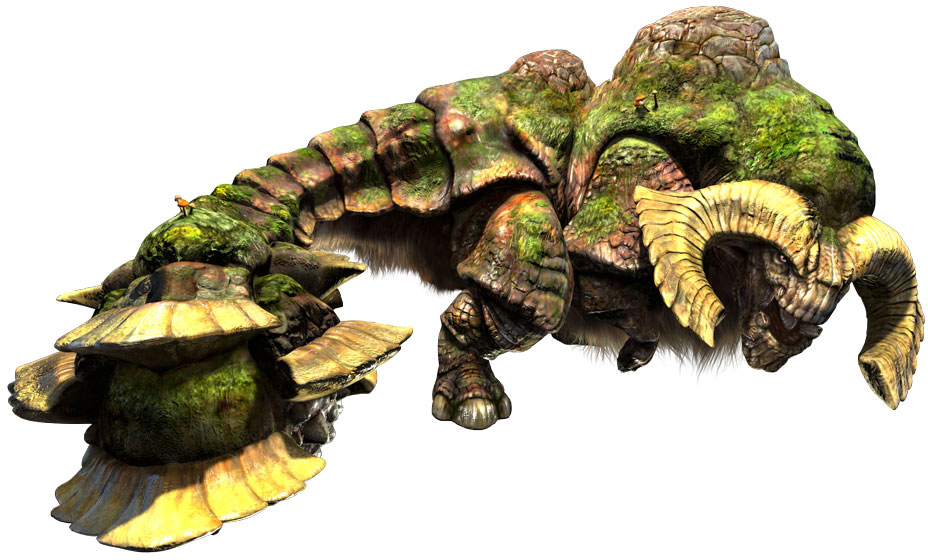
Radobaan
Huge wyvern (brute), unaligned
- Armor Class 15 (19 with Bone Armor)
- Hit Points 136 (13d12 + 52)
- Speed 50 ft.
STR DEX CON INT WIS CHA 21 (+5) 14 (+2) 18 (+4) 5 (-3) 12 (+1) 6 (-2)
- Skills Perception +5
- Damage Resistances fire, lightning
- Senses passive Perception 15
- Languages -
- Challenge 10 (5,900 XP)
Bone Armor. The radobaan is covered in the bones of fallen creatures granting it +4 AC. When the radobaan takes more than 30 damage in a single turn, the bones snap and break reducing the bonus AC by 1.
Actions
Multiattack. The radobaan makes one Tail attack and two Chin Slam attacks.
Tail. Melee Weapon Attack: +9 to hit, reach 5 ft., one target. Hit 21 (3d10 + 5) bludgeoning damage.
Chin Slam. Melee Weapon Attack: +9 to hit, reach 5 ft., one target. Hit 18 (3d8 + 5) bludgeoning damage.
Roll (recharge 5-6). The radobaan rolls its body into a wheel and moves up to its speed, during this move it may move through other creatures without provoking opportunity attacks . Any creatures the radobaan moves through must succeed on a DC 17 Dexterity saving throw or take 42 (12d6) slashing damage and are knocked prone.
Sleeping Gas. (2/per Long rest). The radobaan releases sleeping gas from its underside. All creatures within 15 ft must make a DC 16 Constitution saving throw or, they fall Unconscious until the spell ends, the sleeper takes damage, or someone uses an action to shake or slap the sleeper awake.
Radobaan
Radobaan looks very similar to Uragaan in many aspects but has its own unique features. Unlike Uragaan, Radobaan is covered in a tar-like substance that sticks rows of bones onto its body. These bones vary in size throughout the Radobaan's body but the most distinctive ones are on its legs. The bones on its legs are the horns of Diablos. Though the bones aren't as strong as ore, they are lighter. This lighter weight makes Radobaan faster than Uragaan. Despite not eating ore, Radobaan still has a massive chin like Uragaan. Like Uragaan, Radobaan can roll into a wheel and run over enemies.
It also can emit coma-inducing gas from its body like Uragaan. Radobaan can be fairly calm unless provoked by a threat unlike their ore eating relatives the Uragaan which will become hostile regardless of being threatened or not. Once provoked, they will turn violent.
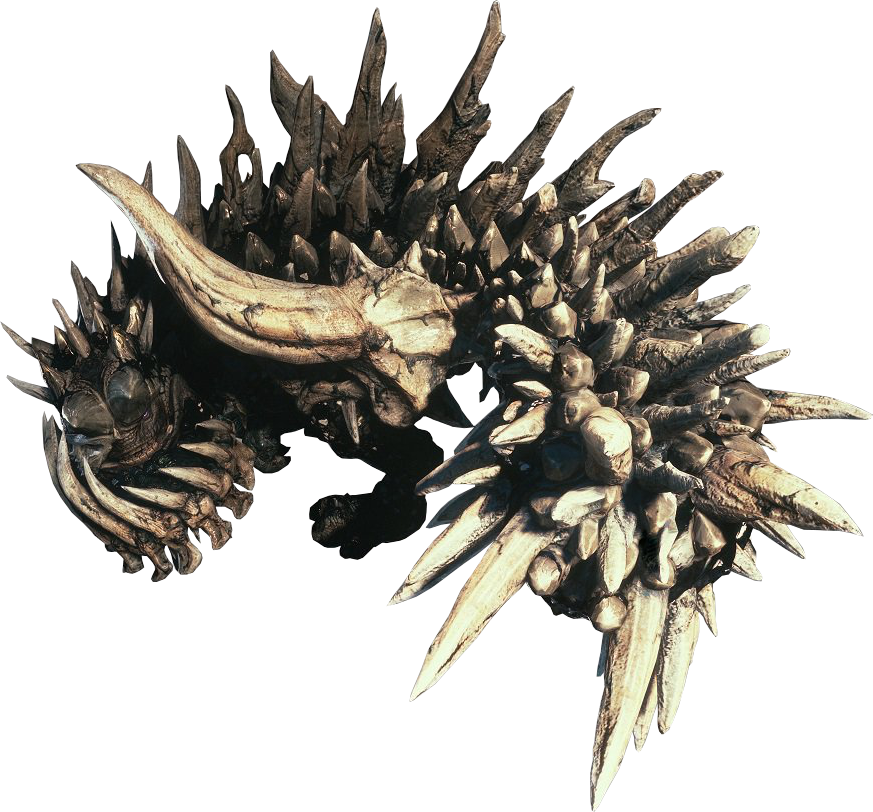
Glavenus
Huge wyvern (brute), unaligned
- Armor Class 18 (natural armor)
- Hit Points 195 (17d12 + 85)
- Speed 50 ft.
STR DEX CON INT WIS CHA 25 (+7) 10 (+0) 21 (+5) 16 (+3) 12 (+1) 10 (+0)
- Saving Throws Str +12, Con +10, Cha +5
- Skills Perception +6
- Damage Resistance fire
- Senses passive Perception 16
- Languages -
- Challenge 13 (10,000 xp)
Actions
Multiattack. The glavenus makes two bite attacks and one tail slash attack, or it uses its sharpening and then its tail spin.
Bite. Melee Weapon Attack: +12 to hit, reach 5 ft., one target. Hit 20 (3d8 + 7) piercing damage + 3 (1d6) fire damage.
Tail Slash. Melee Weapon Attack: +12 to hit, reach 15 ft., one target. Hit 23 (3d10 + 7) slashing damage.
Sharpening. The glavenus sharpens its tail. The next two tail Slashes deal an extra 13 (2d12) of fire damage.
Tail Spin (recharge 5-6) After Sharpening, the glavenus launches itself forward, using its tail to slash at all foes in 15 foot radius around it. Each creature in that area must then make a DC 16 Dexterity saving throw, taking 28(8d6) slashing and 28(8d6) fire damage on a failed save, and half as much on a successful one.
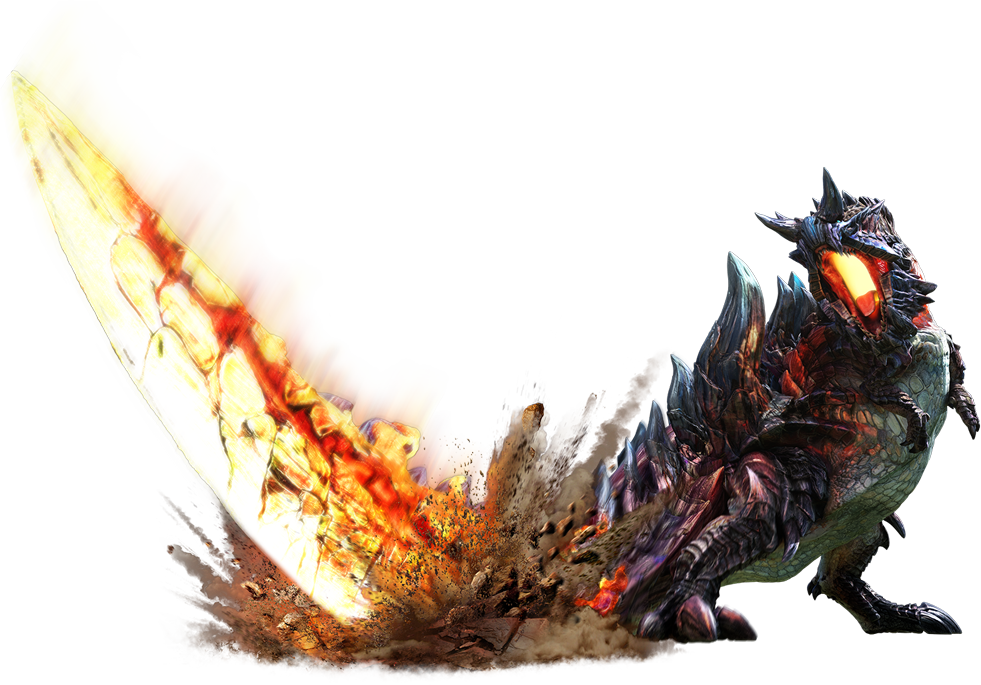
Galvenus
Glavenus is a large Brute Wyvern with dark red scales covering its body. Two rows of blue, bony plates run along its back, going from the eyes to the tail. Its underside is more of a cream color. The main feature of Glavenus's physiology is its huge, sword-like tail. The tail has originally the same color as its back plates, although it will turn a rusty color or a fiery red during the battle. Its hind legs are powerful and muscular, while its front legs are much smaller and mostly useless. The face and mandibles are covered in sturdy plating, particularly resembling a Carnotaurus ' head.
Glavenus most striking feature is its blade-like tail. The blade-like tail is used in many ways by Glavenus such as keeping the body balanced but its primary use is for attacking. This tail can cut prey in two with a single slash, crack the ground easily, and even block some attacks. Though its tail is already a powerful weapon, it can become more dangerous once heated up. By grinding its tail on the ground or nearby hard surfaces violently, it can ignite the tail, heating it up to high temperatures. While its tail is heated all of its tail-based attacks become more deadly, also allowing it to cut through objects much more easily.
Glavenus are relentless and aggressive predators. Glavenus oftens drags its tail across the ground and roars at the foe. This shows the enemy that it uses fire as a weapon in an attempt to scare them off. Not only are they considered one of the strongest Brute Wyverns, they are even believed to be the smartest ones around. Their territory is commonly marked by large gashes on the ground, produced when they scrape their tails along solid objects.
Brachydios
Huge wyvern (brute), unaligned
- Armor Class 19 (natural armor)
- Hit Points 253 (22d12 + 110)
- Speed 40 ft.
STR DEX CON INT WIS CHA 24 (+7) 14 (+2) 20 (+5) 8 (-1) 9 (-1) 9 (-1)
- Saving Throws Str +13, Wis +5
- Damage Immunities fire
- Damage Resistances slashing, piercing
- Senses passive Perception 9
- Languages -
- Challenge 17 (18,000 xp)
Actions
Multiattack. The brachydios makes three attacks, one with its horn and two with its fist.
Horn. Melee Weapon Attack: +13 to hit, reach 5 ft., one target. Hit 20 (3d8 + 7) bludgeoning damage + 3 (1d6) fire damage.
Fist. Melee Weapon Attack: +13 to hit, reach 10 ft., one target. Hit 17 (3d6 + 7) bludgeoning damage. + 3 (1d6) fire damage.
Chemical Reaction (Recharge 5-6). The brachydios slams his horn into the ground and causes a chain of explosions in a 60 foot line that is 10 feet wide. Each creature in that line must make a DC 19 Dexterity saving throw, taking 22 (5d8) fire damage + 18 (4d8) bludgeoning damage on a failed save, or half as much damage on a successful one.
Legendary Actions
The brachydios can take 3 legendary actions, choosing from the options below. Only one legendary action option can be used at a time and only at the end of another creatures turn. The brachydios regains spent legendary actions at the start of its turn.
Move. The brachydios moves up to its speed without provoking opportunity attacks
Fist Attack. The brachydios makes a fist attack.
Slam (Costs 2 Actions). The brachydios makes a horn attack or uses chemical reaction.
Brachydios
Brachydios are easily identifiable by their glowing, green slime-covered horns and "fists," as well as their shiny, armored hide covered in many plates and ridges that are made of obsidian. Unlike other Brute Wyverns, Brachydios sports a pair of long, highly developed forelimbs that it uses as its primary means of defense. Brachydios' forelimbs and horn seem to secrete a mysterious slime.
A Brachydios "primes" this mucus to explode with its saliva, hence why it licks its arms, making it appear brighter green. Despite initial appearances, Brachydios does possess claws on its forearms that are tucked away underneath, and serve no apparent purpose in battle.
The symbiotic slime-mold is easily one of the most unique and defining feature of the Brachydios. The theropods armored shell is hardened to protect against the explosive blasts that the mold creates on impact. A Brachydios skin is similar to that of a thermos flask, giving it the ability to withstand both extreme heat and cold. Brachydios body is the only place this mold can survive without turning explosive. When attacking, Brachydios constantly scrapes copious amounts of this mold off of its body, causing it to deplete. However, it seems that the beast's saliva acts as a powerful stimulant, which causes the mold to almost instantly replenish itself.
Brachydios are extremely aggressive creatures and will not hesitate to attack if they feel threatened or challenged. Due to their aggression they are commonly known to invade the territories of other large predators, usurp them, and claim the territory as their own. They will also show no mercy to small monsters. Young Brachydios will live near their parents and their territory, yet the adults will not show any parental care at all. The young will pick up slime mold left behind by adults. However, this can be dangerous as their hides are underdeveloped and can possibly be seriously injured or even killed by the explosions of the slime mold.
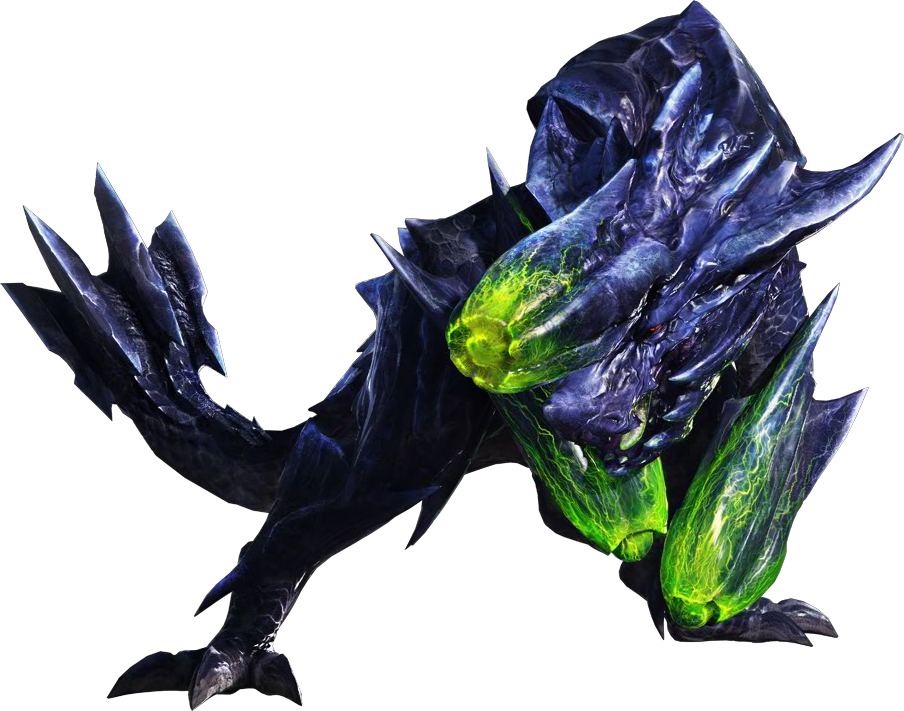
Deviljho
Deviljho is a bipedal Brute Wyvern characterized by its uniform forest green colouration and muscular upper body. Its thick hide is littered with short, jagged spines that reach a maximum height along the back and tail. Deviljho has a narrow snout with a large lower jaw, covered in multiple rows of teeth spreading outwards from the mouth. It has massive, powerful hind legs, but tiny, poorly developed forelegs that it rarely utilizes. Their eyes are small and simple, suggesting their vision is rather poor, but their other senses such as smell may compensate for this. Their tails are long and powerful, but their main feature of note is its breath attack. When provoked, Deviljho back and shoulder muscles swell considerably. During this period, areas of its skin will take on a bright red colouration.
Deviljho is a nomadic monster, prone to wandering vast distances in search of prey. Its status as a super-predator allows it to overtake the territory of any monster that stands in its path. Because of the extreme amount of energy its body consumes, Deviljho is always in search of food sources. It is known to be cannibalistic, and is also prone to eating prey alive in order to waste as little time as possible in replenishing its energy.
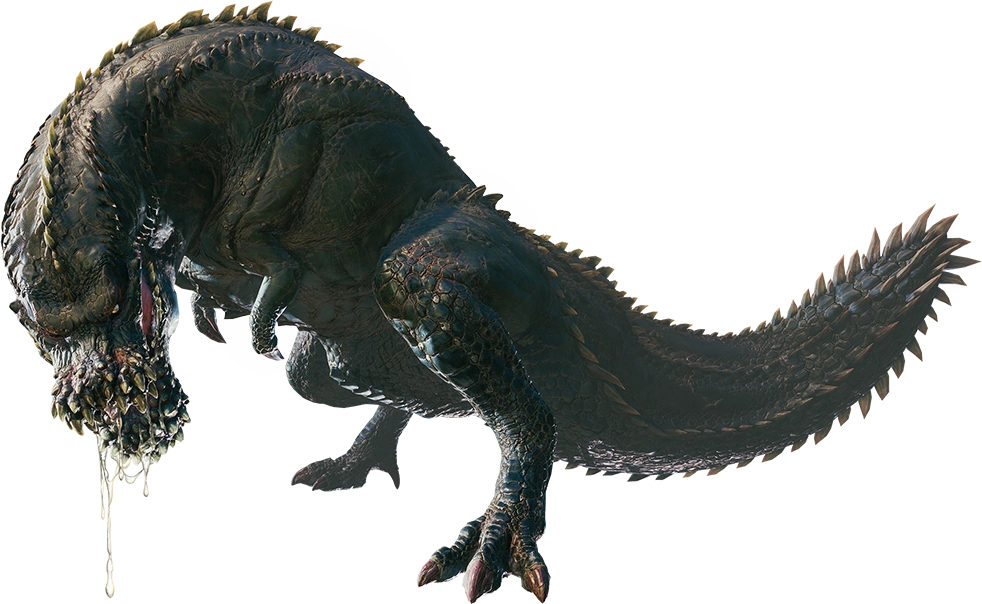
Deviljho
Gargantuan wyvern (brute), unaligned
- Armor Class 19 (natural armor)
- Hit Points 198 (12d20 + 72)
- Speed 50 ft.
STR DEX CON INT WIS CHA 27 (+8) 18 (+4) 23 (+6) 10 (+0) 15 (+2) 8 (-1)
- Saving Throws Str +14, Con +12, Wis +8
- Skills Athletics +14, Intimidation +5, Perception +8
- Condition Immunities Charmed, Frightened, Stunned
- Senses passive Perception 18
- Languages -
- Challenge 18 (20,000 xp)
Charge. If the deviljho moves at least 20 ft. straight toward a target and then hits it with a Body Slam Attack on the same turn, the target takes an extra 11 (2d10) bludgeoning damage.
Legendary Resistance (2/Day). If the deviljho fails a saving throw, it can choose to succeed instead.
Actions
Multiattack. The deviljho makes two attacks, one with its body slam and one with its bite.
Body Slam. Melee Weapon Attack: +14 to hit, reach 5 ft., one target. Hit 30 (4d10 + 8) slashing damage. On a hit, the target must make a DC 22 Strength saving throw or be pushed back 10 ft and knocked prone.
Bite. Melee Weapon Attack: +14 to hit, reach 10 ft., one target. Hit 26 (4d8 + 8) piercing damage.
Tail. Melee Weapon Attack: +14 to hit, reach 20 ft., one target. Hit 21 (2d12 + 8) piercing damage.
Fire Breath (Recharge 5-6). The deviljho unleashes a terrible breath in a 45 foot cone. Each Creature in that area must make a DC 17 Dexterity saving throw, taking 31 (7d8) fire damage plus 45 (10d8) necrotic damage on a failed save, or half as much on a successful one.
Swallow The deviljho makes one bite attack against a Large or smaller creature that is prone. If the attack hits, the target takes the bite damage, the target is swallowed, and no longer prone. While swallowed, the creature is blinded and restrained, it has total cover against attacks and other effects outside the deviljho, and it takes 56 (16d6) acid damage at the start of each of the deviljho turns.
If the deviljho takes 40 damage or more on a single turn from a creature inside it, the deviljho must succeed on a DC 20 Constitution saving throw at the end of that turn or regurgitate all swallowed creatures, which fall prone in a space within 10 feet of the deviljho. If the deviljho dies, a swallowed creature is no longer restrained by it and can escape from the corpse by using 15 feet of movement, exiting prone.Legendary Actions
The deviljho can take 3 legendary actions, choosing from the options below. Only one legendary action option can be used at a time and only at the end of another creatures turn. The deviljho regains spent legendary actions at the start of its turn.
Detect. The deviljho makes a Wisdom (Perception) Check.
Tail Attack. The deviljho makes a Tail attack.
Devour (Costs 2 actions). The deviljho uses its Swallow.
Fanged Wyvern
Fanged Wyverns are known for being Fanged Beast-like Wyvern monsters that have highly developed limbs. Typically ignored by towns and cities due to their preferred territories being far away from civilization. Up until recently scholars only classified the Zinogre as the only known species of these wyverns. New species have been discovered in far off regions, although they are more reptilian in nature when compared to their kin.
Zinogre
Zinogre is a quadrupedal monster that very wolf-like if one looks at its face, and has a very muscular set of forelimbs - very comparable to those of big cats. It has surprising agility for such a large monster, similar to Nargacuga. It has sharp claws attached to strong muscular fore-limbs, which are used to deliver a fatal blow to prey and hunters. It also helps them to climb mountains and rocky terrain. The spikes on its body mostly lie flat, but when it has built up an electric charge they stick out vertically into the air.
The Zinogre can also harness the power of electricity, much like a Lagiacrus, using it to take down larger prey and to defend itself and its territory. Thunderbugs are seen gathering around Zinogre when it is "charging" electricity; they may act as a source of energy. Also, Gargwa are known to eat Thunderbugs, so it is possible that Zinogre has a special relationship with Thunderbugs. As Zinogre preys on Gargwa, Thunderbugs become safe, simply by flying around in close proximity to a Zinogre. Zinogre can exploit this by absorbing the energy emitted by the bugs during battle, granting it special abilities. Thunderbugs might glow blue instead of their normal colour to indicate that they have allied with a Zinogre.If you look close at a Zinogre, you can see a energy field around it. Juvenile Zinogre have more hair on their bodies compared to adults and is white in color. It is believed that the increased hair protects the juvenile's shell and help speeds up the storage of electricity. This fur will shed as the juvenile Zinogre mature into adulthood.
Zinogre are somewhat similar to real wolves, they even howl like them. But they do not form packs, quite the contrary, they are solitary hunters. This is no surprise, since they are extremely powerful and agile monsters, not needing teamwork to take down prey. According to eyewitnesses adult Zinogre make herds and raise their young. During this period of time it is ill-advised to go hunting Zinogre as the adults will aggressively attack any intruders getting too close to their offspring
Zinogre
Huge wyvern (fanged), unaligned
- Armor Class 18 (natural armor)
- Hit Points 189 (18d12 + 72)
- Speed 40 ft.
STR DEX CON INT WIS CHA 21 (+5) 15 (+2) 18 (+4) 8 (-1) 14 (+2) 9 (-1)
- Skills Perception +6, Survival +6
- Damage Immunities Lightning
- Senses darkvision 60 ft., passive Perception 16
- Languages -
- Challenge 10 (5,900 xp)
Lightning Aura. When the zinogre uses Charge, it becomes shrouded in an aura of lightning. If a creature ends its turn within 5 feet of the zinogre, that creature takes 7 (2d6) lightning damage.
Actions
Multiattack. The zingore makes three attacks, two with its claws and one with its tail attack.
Charge (recharge 6). The zinogre gathers thunderbugs giving it a lightning Aura for 1 minute. As the zinogre finishes charging lightning explodes in a 10 foot radius around the zinogre. Each creature in the area must make a DC 16 Strength saving throw, or be knocked back 10 feet and taking 38 (11d6) lightning damage on a failed saving throw or half as much damage on a successful save and isn't knocked prone.
Claws. Melee Weapon Attack. +9 to hit, reach 5 ft., one target. Hit 18 (3d8 + 5) piercing damage plus 3 (1d6) lightning damage.
Tail. Melee Weapon Attack. +9 to hit, reach 10 ft., one target. Hit 24 (3d12 + 5) bludgeoning damage plus 3 (1d6) lightning damage.
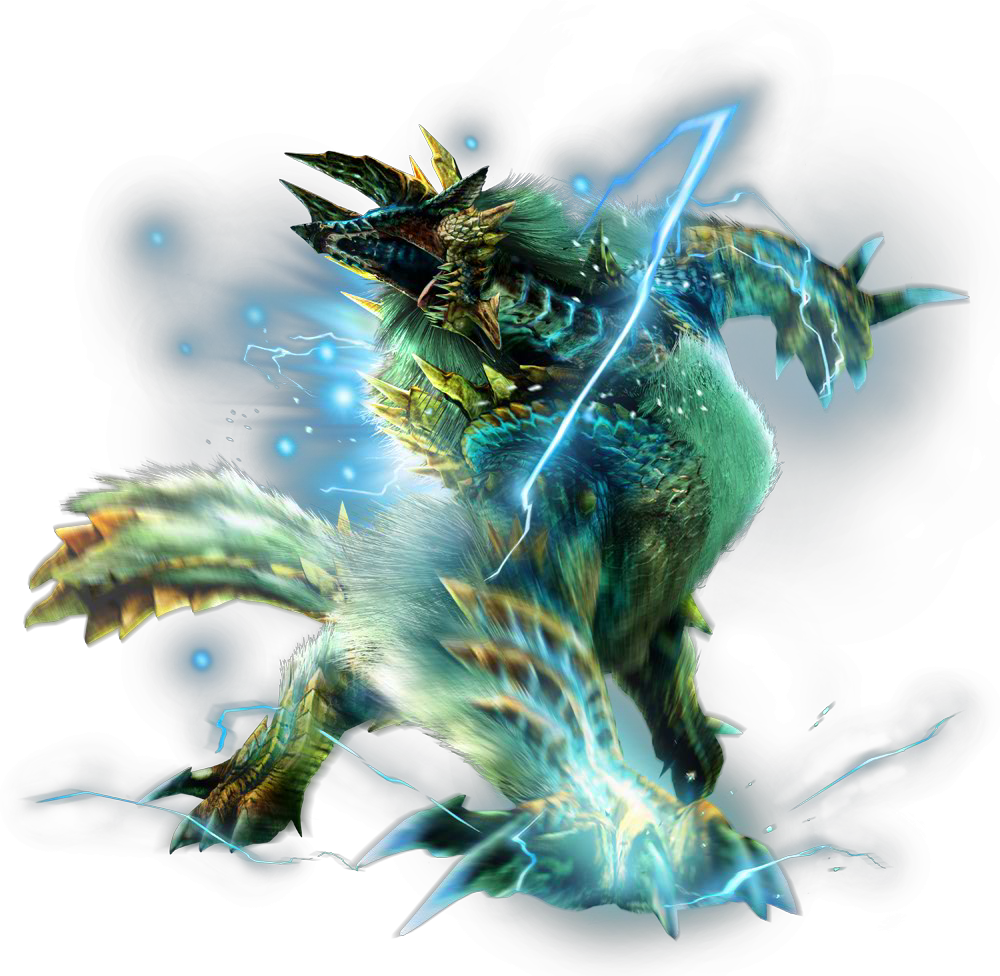
Jagras
Jagras are small and slim compared to Great Jagras. Their body shape is very wolf-like in nature, allowing them to move quickly and stand up right for short periods of time. Jagras have light green scales with blue and reddish stripes covering their body, as well as a blue-colored underbelly.
Jagras will swarm potential prey in an instant, whether it be carrion or raw meat dropped by a hunter. Jagras packs have even been seen attacking injured Anjanath. Though they are bold, Jagras will flee to the trees if they encounter a larger monster.
Great Jagras
Great Jagras greatly resembles an Iguana. It has yellow scales with orange accents and a bluish underside. It also has a distinct mane of hairs that resemble dreadlocks. The monster has incredible stomach capacity and often swallows prey whole, greatly distending its belly. They are typically passive toward adventurers until attacked.
Jagras
Medium wyvern (fanged), unaligned
- Armor Class 11 (natural armor)
- Hit Points 19 (3d8 + 6)
- Speed 40 ft.
STR DEX CON INT WIS CHA 15 (+2) 10 (+0) 14 (+2) 2 (-4) 12 (+1) 7 (-2)
- Skills Perception +3
- Senses passive Perception 13
- Languages -
- Challenge 1/2 (100 XP)
Actions
Multiattack. The jagras makes two bite attacks.
Bite. Melee Weapon Attack: +4 to hit, reach 5 ft., one target. Hit: 5 (1d6 + 2) piercing damage.
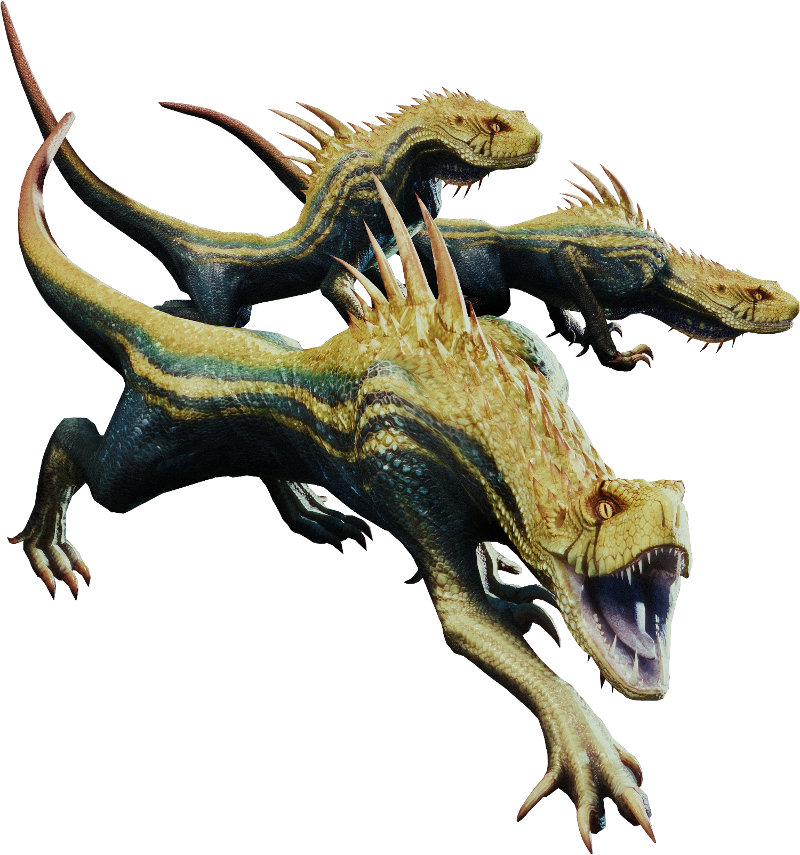

Great Jagras
Large wyvern (fanged), unaligned
- Armor Class 15 (natural armor)
- Hit Points 90 (12d10 + 24)
- Speed 40 ft.
STR DEX CON INT WIS CHA 16 (+3) 10 (+0) 16 (+3) 2 (-4) 12 (+1) 7 (-2)
- Skills Perception +3
- Damage immunities cold
- Senses passive Perception 13
- Languages -
- Challenge 4 (1,100 XP)
Full Belly. While the great jagras has a creature swallowed its belly expands, reducing its movement speed by 10 feet., rolls one additional weapon damage die on Strength-based weapon attacks, and it can use its Roll attack.
Actions
Multiattack. The great jagras makes one bite attack and one claw attack.
Bite. Melee Weapon Attack: +5 to hit, reach 5 ft., one target. Hit 10 (2d6 + 3) piercing damage and the target is grappled (escape DC 13). Until this grapple ends, the target is restrained, and the great jagras can't bite another target.
Claw. Melee Weapon Attack: +5 to hit, reach 5 ft., one target. Hit: 10 (3d4 + 3) slashing damage.
Swallow. The great jagras makes one bite attack against a Medium or smaller target it is grappling. If the attack hits, the target is swallowed, and the grapple ends. The swallowed target is blinded and restrained, it has total cover against attacks and other effects outside the great jagras, and it takes 10 (3d6) acid damage at the start of each of the great jagras's turns. The great jagras can have only one target swallowed at a time. If the great jagras dies, a swallowed creature is no longer restrained by it and can escape from the corpse using 5 feet of movement, exiting prone.
Rollover (Must have a creature swallowed, recharge 5-6). The great jagras rolls over, moving up to half its movement speed, without provoking an attack of opportunity. If the great jagras enters a space containing a creature, that creature must make a DC 13 Dexterity saving throw, or be knocked prone and take 17 (4d6+3) bludgeoning damage on a failed save. On a successful save, the creature takes only half the damage, isn't knocked prone, and is pushed 5 feet out of the great jagras's space into an unoccupied space of the creature's choice. If no unoccupied space is with in range, the creature instead falls prone in the great jagras's space.
Girros
Girros are snake-like Fanged Wyverns with a head and hood similar to a cobra. They have black onyx scales with yellow stripes on their neck. Girros also have red gill-like organs on the side of their neck. Girros have a paralyzing venom in their fangs used to incapacitate their prey.
Great Girros
Great Girros greatly resembles a cobra in appearance though walks on all fours like a monitor. It is covered in black onyx scales and has yellow stripes running down the back of its neck. On the side of its neck is a hood with red gill-like organs. Great Girros has large fangs filled with a paralyzing venom. It just takes a single bite from these fangs to paralyze prey as big as Radobaan. It can also spit a yellow fluid from its mouth that can paralyze prey. Great Girros also possesses the ability to call Girros during a fight to swarm it's prey with a barrage of paralyzing bites.
Great Girros is an active scavenger that is constantly looking for new corpses to feed on. Great Girros is also surprisingly aggressive as it will attack even Odogaron who is the Apex Monster of the Rotten Vale. Great Girros will fight any monster it can swarm with regular Girros.
Girros
Small wyvern (fanged), unaligned
- Armor Class 14 (natural armor)
- Hit Points 44 (8d6 + 16)
- Speed 40 ft.
STR DEX CON INT WIS CHA 15 (+2) 10 (+0) 14 (+2) 2 (-4) 12 (+1) 7 (-2)
- Skills Perception +3
- Condition Immunities paralyzed
- Senses darkvision 60 ft., passive Perception 13
- Languages -
- Challenge 1 (200 XP)
Pack Tactics. The girros has advantage on an attack roll against a creature if at least one of the girros's allies is within 5 feet of the creature and the ally isn't incapacitated.
Actions
Multiattack. The girros makes two bite attacks.
Bite. Melee Weapon Attack: +4 to hit, reach 5 ft., one target. Hit: 5 (1d6 + 2) piercing damage and the target must make a DC 11 Constitution saving throw, taking 9 (2d8) poison damage on a failed save, or half as much damage on a successful one. If the poison damage reduces the target to 0 hit points, the target is stable but poisoned for 1 hour, even after regaining hit points, and is paralyzed while poisoned in this way.
Great Girros
Large wyvern (fanged), unaligned
- Armor Class 15 (natural armor)
- Hit Points 123 (13d10 + 52)
- Speed 40 ft.
STR DEX CON INT WIS CHA 19 (+4) 11 (+0) 19 (+4) 3 (-4) 14 (+2) 10 (+0)
- Skills Perception +5
- Saving Throws Con +7
- Condition Immunities paralyzed
- Senses darkvision 60 ft., passive Perception 15
- Languages -
- Challenge 6 (2,300 XP)
Charge. If the great girros moves at least 20 feet straight toward a target and then hits it with a bite attack on the same turn, the target takes an extra 7 (2d6) damage. If the target is a creature, it must succeed on a DC 15 Strength saving throw or be knocked prone.
Actions
Multiattack. The great girros makes three bite attacks.
Bite. Melee Weapon Attack: +7 to hit, reach 5 ft., one target. Hit: 11 (2d6 + 4) piercing damage and the target must make a DC 15 Constitution saving throw, taking 7 (2d6) poison damage on a failed save, or half as much damage on a successful one. If the poison damage reduces the target to 0 hit points, the target is stable but poisoned for 1 hour, even after regaining hit points, and is paralyzed while poisoned in this way.
Paralyzing Spit. Range Weapon Attack: +7 to hit, range 30/120 ft., one target. Hit: The creature is poisoned. While poisoned in this way the target is paralyzed for 1 minute. A creature can make a DC 15 Constitution saving throw at the end of each of its turns, ending the effect on itself on a success.
Alpha Call (1/day). The great girros calls out for help and 2 (1d4) girros appears to assist it.
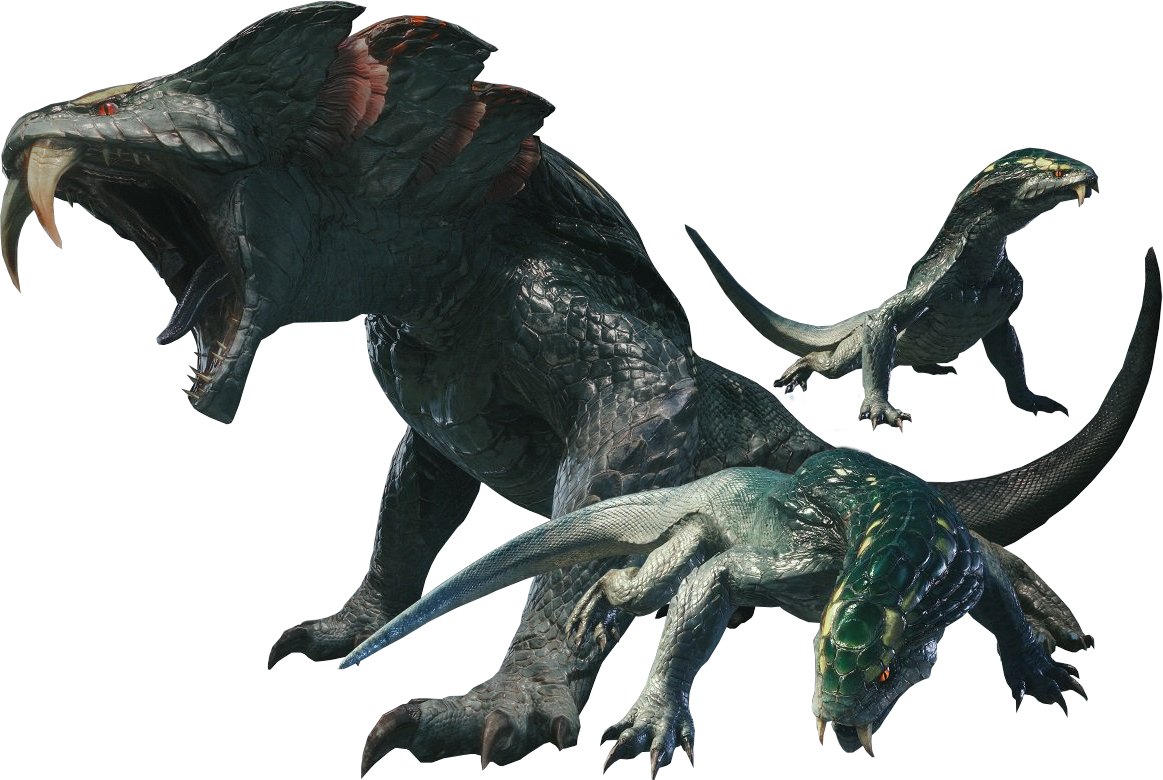
Dodogama
Dodogama has blue scales with orange stripes covering its body. It has a massive bottom jaw used for storing rocks in its mouth, which will turn orange when they become volatile. Dodogama is known to eat rocks for defense. When these rocks are combined with its saliva, they become explosive in nature, becoming a powerful projectile that it can spit at predators.
Dodogama
Large wyvern (fanged), unaligned
- Armor Class 16 (natural armor)
- Hit Points 152 (16d10 + 64)
- Speed 40 ft.
STR DEX CON INT WIS CHA 20 (+5) 9 (-1) 18 (+4) 3 (-4) 14 (+2) 10 (+0)
- Saving Throws Con +7, Cha +3
- Senses passive Perception 12
- Languages -
- Challenge 7 (2,900 XP)
Charge. If the dodogama moves at least 20 feet straight toward a target and then hits it with a bite attack on the same turn, the target takes an extra 9 (2d8) damage. If the target is a creature, it must succeed on a DC 15 Strength saving throw or be knocked prone.
Actions
Multiattack. The dodogama makes two bite attacks.
Bite. Melee Weapon Attack: +8 to hit, reach 5 ft., one target. Hit: 14 (2d8 + 5) piercing damage plus 7 (2d6) fire damage.
Molten Rock. Range Weapon Attack: +8 to hit, range 30/120 ft., one target. Hit: 12 (2d6 + 5) bludgeoning damage plus 7 (2d6) fire damage.
Shamos
Shamos has a wolf-like body shape with huge orange eyes. Though its body shape is akin to a wolf, Shamos' appearance is very similar to fish. Its face is covered in red scales while the rest of its body is covered in grayish-white splotches. Its limbs are navy blue in color. Shamos also has a small fin on its back like a fish. Shamos has unusually large eyes that allow it to see in pure darkness. Shamos are aggressive hunters that will attack in small packs. They will often group together in order to scare off potential predators such as Tzitzi-Ya-Ku.
Shamos
Small wyvern (fanged), unaligned
- Armor Class 14 (natural armor)
- Hit Points 45 (10d6 + 10)
- Speed 30 ft.
STR DEX CON INT WIS CHA 16 (+3) 12 (+1) 13 (+1) 3 (-4) 9 (-1) 7 (-2)
- Senses darkvision 60 ft., passive Perception 9
- Languages -
- Challenge 1 (200 XP)
Pack Tactics. The shamos has advantage on an attack roll against a creature if at least one of the girros's allies is within 5 feet of the creature and the ally isn't incapacitated.
Actions
Multiattack. The shamos makes two bite attacks.
Bite. Melee Weapon Attack: +5 to hit, reach 5 ft., one target. Hit: 6 (1d6 + 3) piercing damage.
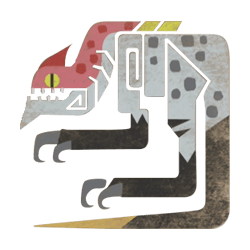
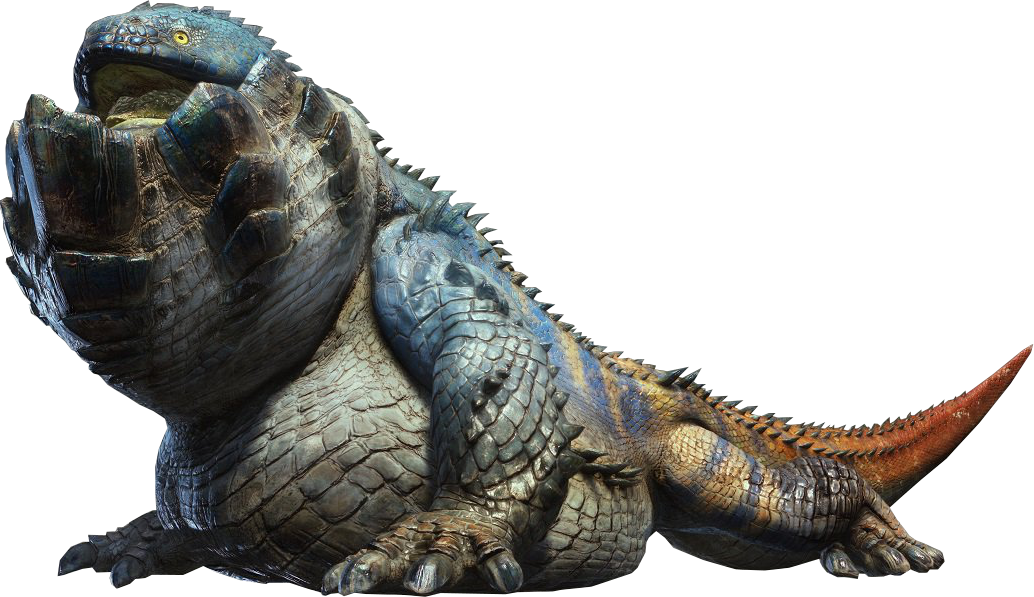
Tobi-Kadachi
Tobi-Kadachi's face resembles a colubrid in appearance with grayish blue scales covering its slim squirrel-like shape. On its back are patches of white fur as well as a bushy tail covered in rows of spikes. Its front limbs also have a few spikes.
As Tobi-Kadachi fights, it picks up static electricity in its fur by brushing against trees and the ground. Tobi-Kadachi uses this static electricity to increase the strength of its attacks. Like a flying squirrel, Tobi-Kadachi has a membrane between its limbs that allow it to glide for long distances.
Tobi-Kadachi
Large wyvern (fanged), unaligned
- Armor Class 14 (natural armor)
- Hit Points 123 (13d10 + 52)
- Speed 30 ft., climb 30 ft., glide 60 ft.
STR DEX CON INT WIS CHA 18 (+4) 12 (+1) 19 (+4) 3 (-4) 14 (+2) 10 (+0)
- Saving Throws Dex +4
- Damage Immunities lightning
- Senses darkvision 60 ft., passive Perception 12
- Languages -
- Challenge 6 (2,300 XP)
Wounded Fury. While it has 62 hit points or fewer, the tobi-kadachi has advantage on attack rolls. In addition, it deals an extra 7 (2d6) lightning damage to any target it hits with a melee attack.
Standing Leap. The tobi-kadachi's long jump is up to 20 feet and its high jump is up to 10 feet, with or without a running start.
Gliding. When the tobi-kadachi glides, it loses 5 feet of altitude for every 10 feet of movement. At the end of its glide the tobi-kadachi falls to the ground if it is still in the air.
Actions
Multiattack. The tobi-kadachi makes three attacks: two with its bite and one with its tail.
Bite. Melee Weapon Attack: +7 to hit, reach 5 ft., one target. Hit: 13 (2d8 + 4) piercing damage.
Tail. Melee Weapon Attack: +7 to hit, range 10 ft., one target. Hit: 15 (2d10 + 4) bludgeoning damage.
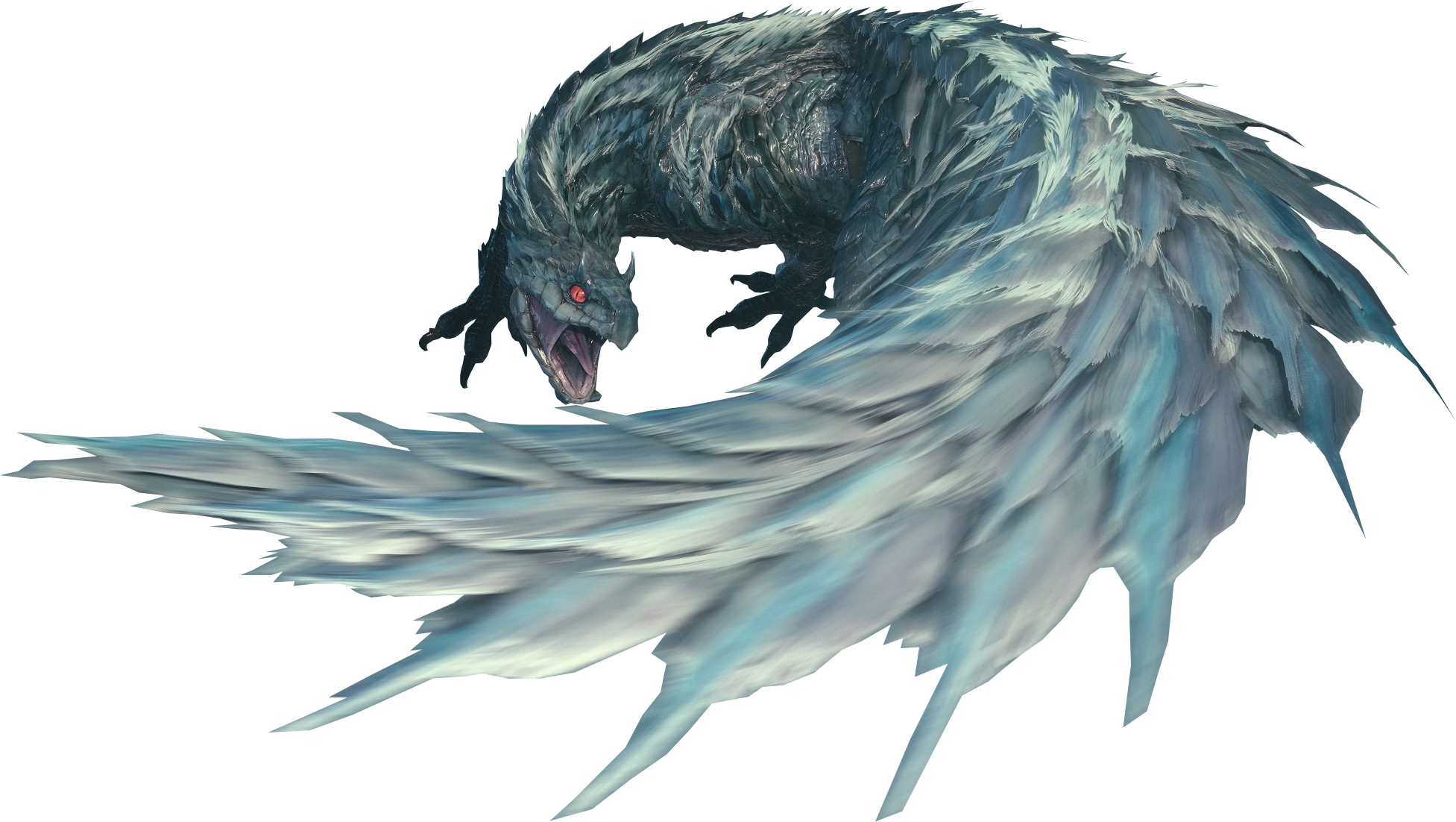
Odogaron
Odogaron resembles a gruesome feral dog. It is covered in red scales and bony protrusions that resemble muscle tissue and bone. Its tail is particularly bony and can be used as a club. The monster has piercing blue eyes. Odogaron's most distinctive feature is its double row of claws, which it uses to inflict deep wounds in its prey, causing them to bleed to death.
Despite its size, Odogaron is quite an agile monster. It is able to rush down prey before delivering bites with its powerful jaws. Odogaron makes its home in the Underdark, where it can be seen dragging back the carcasses of its prey. However, it will venture up to the surface above in search of prey, where it assumes an apex role in the food chain alongside Legiana.
Odogaron is a hostile monster that will attack anything that it encounters on sight, no matter how big a prey item is. This monster is even willing to attack Vaal Hazak an elder dragon despite essentially confronting a primordial force.
Odogaron
Large wyvern (fanged), unaligned
- Armor Class 16 (natural armor)
- Hit Points 161 (17d10 + 68)
- Speed 50 ft., climb 30 ft.
STR DEX CON INT WIS CHA 18 (+4) 15 (+2) 18 (+4) 11 (+0) 12 (+1) 14 (+2)
- Skills Athletics +7, Acrobatics +5, Perception +4
- Saving Throws Con +7, Wis +4, Cha +5
- Damage Resistances fire
- Senses darkvision 120 ft., passive Perception 14
- Languages -
- Challenge 8 (3,900 XP)
Rampage. When the odogaron reduces a creature to 0 hit points with a melee attack on its turn, the odogaron can take a bonus action to move up to half its speed and make a claw attack.
Actions
Multiattack. The odogaron makes three attacks; one bite attack and two claw attacks.
Bite. Melee Weapon Attack: +7 to hit, reach 5 ft., one target. Hit: 13 (2d8 + 4) piercing damage and the target is grappled (escape DC 14).
Claws. Melee Weapon Attack: +7 to hit, reach 10 ft., one target. Hit 11 (2d6 + 4) slashing damage. If the target is a creature other than an undead or a construct, it must succeed on a DC 15 Constitution saving throw or lose 5 (1d10) hit points at the start of each of its turns due to an bloody wound. Each time the odogaron hits the wounded target with this attack, the damage dealt by the wound increases by 5 (1d10). Any creature can take an action to stanch the wound with a successful DC 12 Wisdom (Medicine) check. The wound also closes if the target receives magical healing.
Reactions
Uncanny Dodge. The Odogaron halves the damage that it takes from an attack that hits it. The odogaron must be able to see the attacker.
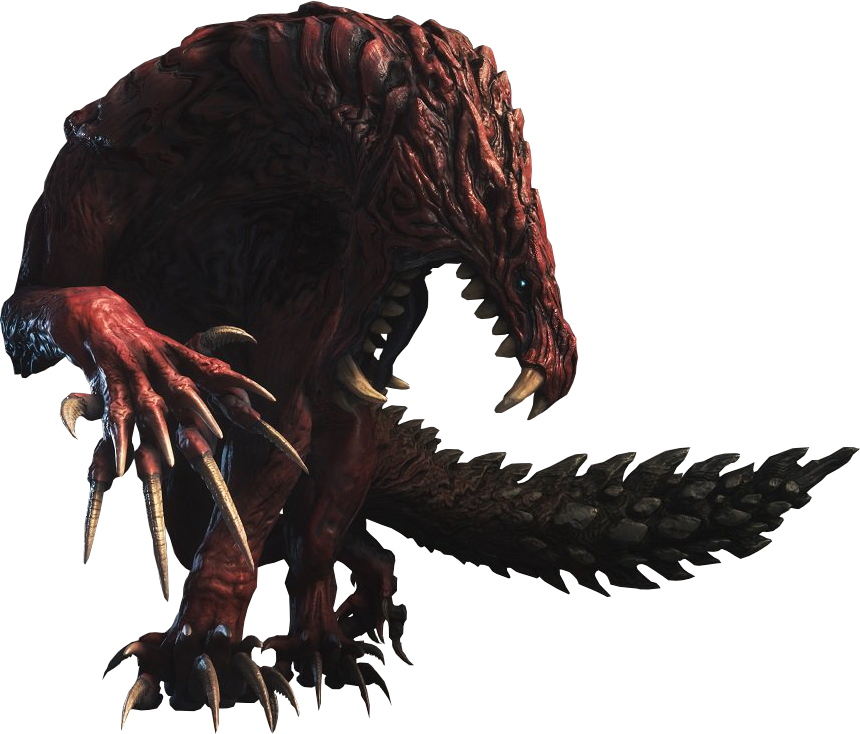
Unknown
Unknown, are a class of monsters that has been identified by scholars, but not yet given a proper classification.
Gore Magala
Gore Magala is unlike anything anyone has ever seen before. In light of the discovery that it is the juvenile form of the Shagaru Magala, some scholars have proposed that it be classified as an Elder Dragon , but until a consensus is reached it has been given the placeholder classification of Unknown.
Gore Magala is a very unique wyvern, sharing traits and similarities to that of the Elder Dragons, possessing six limbs, including the clawed wings on its back. Though, its overall appearance and stance resembles a quadrupedal wyvern like the Nargacuga. Its body is covered in dark exoskeleton plates, with notable features including the hidden feelers that are folded alongside its face, the lack of visible eyes and fanged jaws that are actually parts of its external armor plates. The other unique part is its wings, which are covered in jet-black fur that resemble a tattered and ragged cape. The claws on its wings are extremely prehensile, and even seem to possess opposable thumbs. They are used for grabbing, help at running and maintaining stability. When not engaged in combat, Gore Magala tends to cloak its body with its wings by latching them onto its back.
Gore Magala has an unusually high metabolism but rarely feeds on much prey. Due to this metabolism, its hairs on its wings are constantly left behind and flying in the air. These hairs are used to understand their environment and leave behind a trail that Gore Magala uses to see both predators and prey by heat. Once it smells something in the area, it will begin to spread around its hairs around the area in order to find the target and these hairs will attach onto the target, allowing the Gore Magala to see them with heat. As Gore Magala's senses increase and become better from these hairs, its color under its wings will slowly change and get brighter. When its sense are at their highest peak, two antennae will appear from its head and it will release a large amounts of hairs into the air. The hairs in the sky will darken the sky as if an eclipse was in the area and it will begin to walk on all six. This is its Frenzy State. When it enters this state, it will begin to use its wing claws to allow it to walk and attack better using them. These claws can leave deep gouges in prey that are said to never heal.
Gore Magala's most infamous feature is the Frenzy Virus. This virus is spread from Gore Magala's scales and hairs while its breath has similar properties to them. When in its Frenzy State, Gore Magala is able to make explosions in the area by combining the hairs in the atmosphere around it with a spark from its mouth. The Frenzy Virus causes some abnormalities in the nervous system, increased physical strength, and a decrease in the body's resistance. This virus makes all monsters extremely violent and eventually kills most of them. Some may overcome the effects of the Frenzy Virus and actually develop a relationship with it, becoming physically stronger from the virus while also spreading the virus like Gore Magala in order to get rid of competition from their own species. These rare individuals are known as Apex Monsters.
Gore Magala's are highly aggressive, elusive monsters. These monsters show great amounts of aggression and have shown great amounts of intelligence. Some have even been shown to play dead before slipping away when given an opportunity too. Despite competing with other powerful predators, Gore Magalas have rarely been seen with any wounds or scars on their body. Though these monsters are aggressive, they are more aggressive when it's time for them to return to the Heaven's Mount and go to the Sanctuary. The reason for this is for the Gore Magala to molt into a legendary Shagaru Magala that once nearly wiped out every living thing in the mountains.
Interestingly, Gore Magala have been known to attack seafaring ships during their voyages across the great seas.
Shagaru Magala
Shagaru Magala is the "adult" form of Gore Magala, which transforms by shedding its black skin. Following the skin-shedding, its body is now covered in glittering golden scales, as well as its horns, claws and other spiky protrusions, which changed colors from crimson red / purple to dark brown. The once hidden eyes underneath the horns are also now fully opened. Its ragged-tattered wings also became golden scaly sheets that when fully expanded, resembles a star shape (more specifically, when both wings are expanded.)
Having reached adulthood, Shagaru Magala physical abilities are greatly enhanced; they are much stronger, more agile, and most of all, more ferocious. Apart from more aggressive melee attacks like the clawed wings-pounce and a grab attack that involves crushing and then hurling hunters around like a ragdoll, their virus breath attacks are also enhanced; with the range of the explosion being larger and dealing more damage.
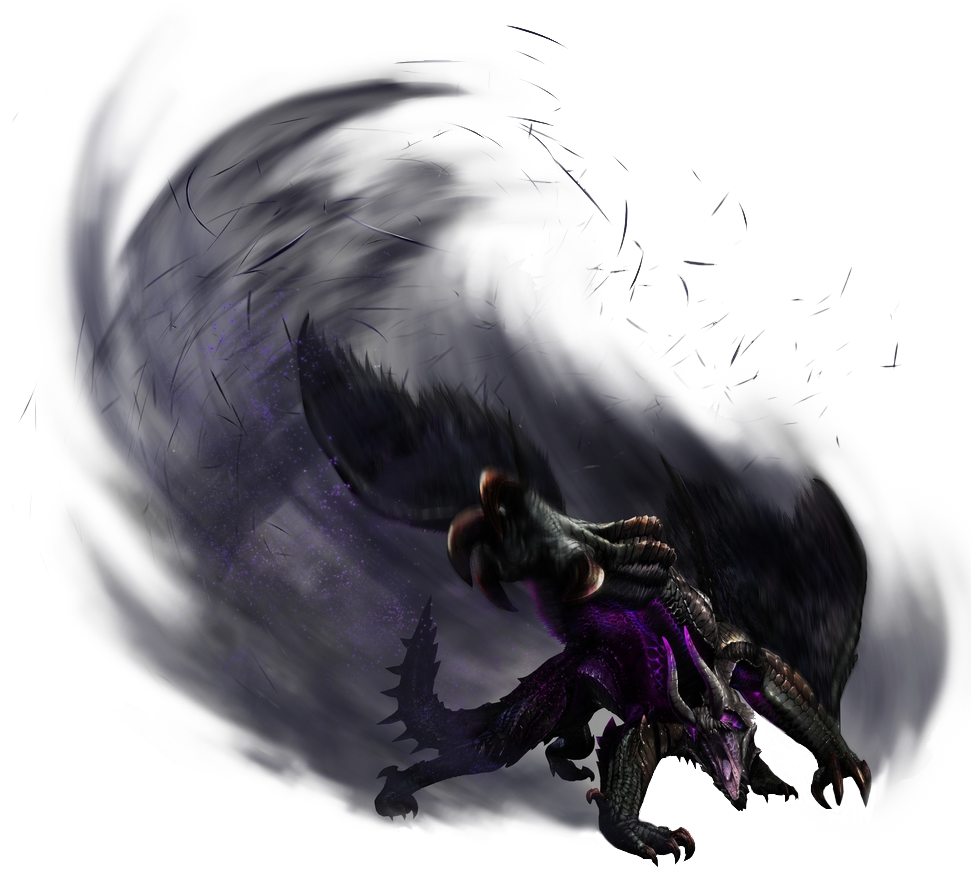
Like its "juvenile" form these drakes have highly specialized wings ending with four large talons at the end that can act as an extra pair of arms. This is very useful when climbing up cliff faces or gripping struggling prey. When exposed to bright sunlight its wings will also refract light into multicolored rays. In their juvenile form as a Gore Magala it lacks eyes, but upon metamorphosing it loses its heat sensors and gains useable eyes. Unlike a Gore Magala it lacks the virus carrying hairs on its wings and instead uses a currently unknown mechanism to spread the Frenzy Virus. A Shagaru Magala is capable of making the Frenzy Virus cover a much greater range than that of its "juvenile" form and has the potential of killing every animal in a single area. The virus strain also seems to be more intense, easily corrupting a mighty beast like Zinogre and turning pack-monsters like the Great Baggi and Baggi against each other. The dark virus aura that envelops a Shagaru Magala is so intense that it's said to dissipate only once the progenitor monster is dead.
These dragons are highly aggressive and territorial predators that won't hesitate in attacking hunters if spotted. Like elder dragons, Shagaru Magala are very rare and are considered myths in some lands. Part of this due to the fact that it takes years for a Gore Magala to molt. Many believe that when the molting process is about to begin said creature will travel to the Heaven's Mount to complete the process. In legend Shagaru Magala is known as "The Punishing God of the Mountains" due to its role of nearly wiping out all life in the mountains. The reason for this is to claim territory for themselves, prevent rivals from molting properly, and to release the next generation of Gore Magala into their territory. Their infected mist not only contains a stronger version of the Frenzy Virus but also their parasitic offspring. Their offspring live in an infected host, whether it is dead or alive, and their host acts as nursery for the young. They get their nutrition and everything they need from their host before eventually bursting out of their host's body. Once Shagaru Magala is finished breeding in a territory, it'll leave the area for its next generation and begin to wander around the world randomly. They don't reproduce again for quite awhile due to trying to prevent future monster generations from gaining a resistance against their virus while reproducing. Thus far, only three Shagaru Magala have been sighted, two of which have been killed. Many people believe that the Shagaru Magala and Gore Magala represent light and darkness.
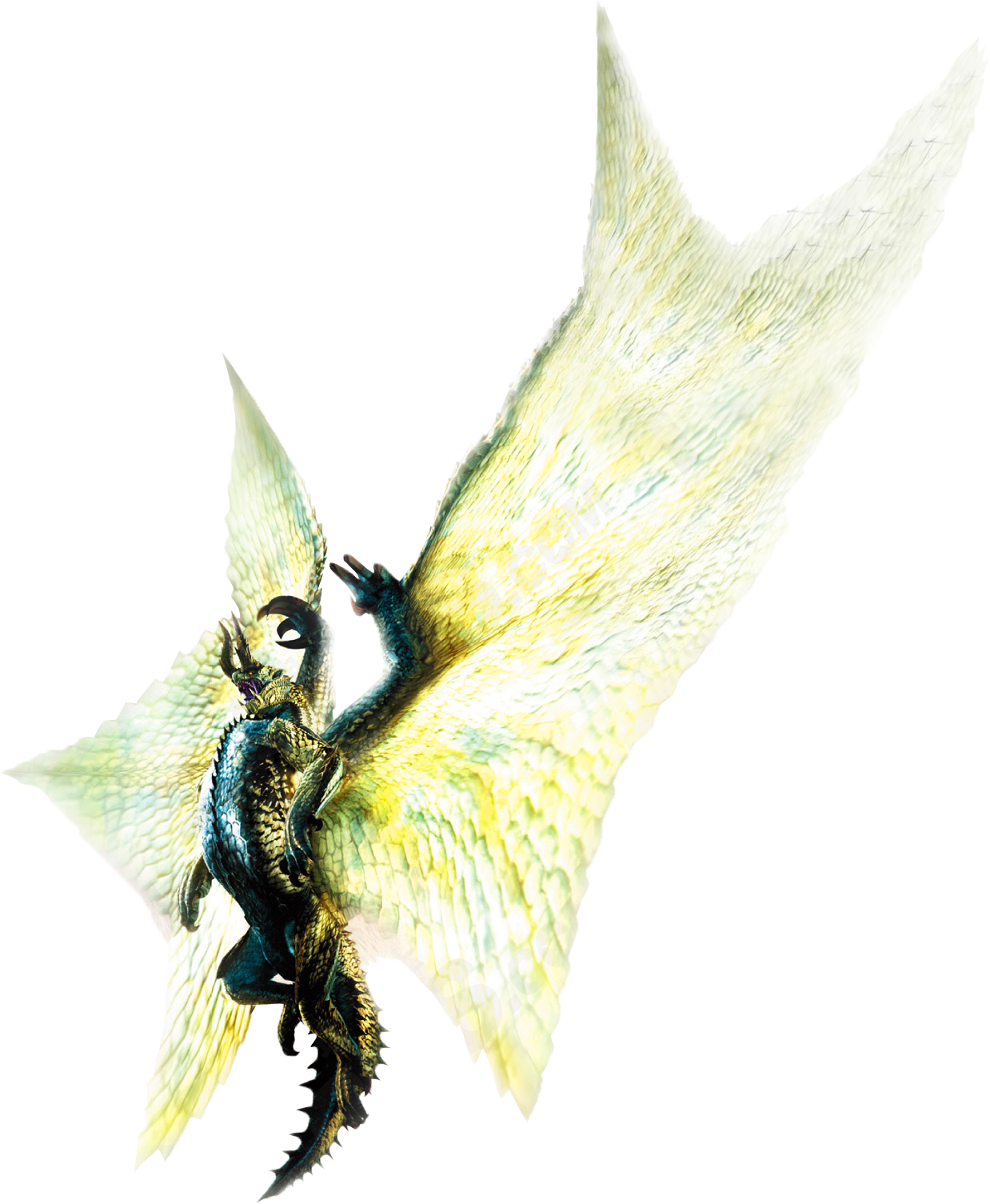
Frenzy Virus
The Frenzy Virus is an infectious disease caused by the attacks and breath weapons of Gore Magala and Shagaru Magala, affecting both sentient races and monsters alike.
Signs and Symptoms
In large creatures, the Frenzy Virus causes a notable discoloration of the skin, fur, feathers, or hide, resulting in a dark purple hue all over the body. In addition, the monster's eyes will become a bright red and it will begin to huff a dark purple smoke from its mouth as it exhales. The Frenzy Virus causes massively heightened aggression, speed, and strength in monsters, making them dangerously short-tempered and ferocious. The Frenzy Virus also seems to affect a monster's vocal cords, rendering all vocalizations shrill and harsh.
In sentient races, the Frenzy Virus effects are significantly different. Once infected, a person will experience a nullification of their natural healing abilities, making it impossible to recover health without the aid of magic. They additionally receive more damage from a frenzied monster's attacks and lose any absorption, immunity, or resistance they may have. They do gain some benefits while under the effects of the frenzied virus, their ferocity increases making it more like to deal critical damage to a creature in addition to increasing the damage they would normally cause.
Prognosis
In sentient races, the virus is not known to be fatal, despite its harmful effects; once the infection has begun, its effects generally last for several minutes before vanishing. Most monsters, on the other hand, die from the Frenzy Virus within a matter of days if they are not killed by hunters first.
The Apex State
When monsters manage to overcome the Frenzy Virus they will be able to suppress the Virus' fatal afflictions while retaining its benefits; and even use the virus itself and weaponize it for their own use, turning them into a completely new threat entirely. This is referred as the Apex State.
Similarly to the Frenzy Virus, monsters affected by the Apex State will have a dark purple hue over their bodies with the addition of some reddish shades. Their eyes will also be red, and they will exhale a dark mist from their mouths. The main aesthetic difference from Frenzy Virus is that Apex monsters will be surrounded by a dark smoke-like aura at all times. A monster's roar will also be greatly distorted when affected by the Apex State.
In full control of the Frenzy Virus with no ill effect, the monster under the Apex state is far more brutal, durable and relentless than they would be under the regular effects of the Virus. In addition to infecting unfortunate victims, some of the Apex monster's attacks may also be enhanced in this state with various upgrades such as longer range or increased damage. While under the Apex state, their skin is far more rigid and harder to damage, They gain resistance to cold, fire, lightning, and thunder damage in addition to immunity to bludgeoning, piercing, and slashing damage from nonmagical weapons.
Infection of the Frenzy Virus
The most common method of infection is a claw or bite attack by an infected creature, but it is also possible to contract by spores from a breath attack. When a creature infected with the virus hit a creature with one of these abilities they gain a Frenzy Charge. When a creature gains 3 charges, they must make a Constitution saving throw, with a DC of 8 + the infected creature's proficiency bonus + the infected creatures Constitution modifier. On a failure, the creature is infected with the Frenzy Virus. A sentient creature may repeat this saving throw each day at Dawn to destroy the virus and recover from its effects. The virus may also be cured by a Greater Restoration spell.
A monster may repeat this saving throw each day at Dawn. After succeeding on three of these saving throws, the creature's immune system suppresses the fatal afflictions but retains its benefits. After failing three of these saving throws, the creature dies.
Sentient Races
When a sentient creature contracts the frenzy virus, it gains the following effects.
Improved Critical. The sentient creature weapon attacks score a critical hit on a roll of 19 or 20.
Improved Damage. All spells and attacks deal an additional 1d4 damage.
Impaired Healing. The creature cannot regain Hit Points except by magical means. Potions of healing are not considered magical for this effect.
Suppressed Immunities. The creature no longer benefits from any resistance, absorption, or immunity for conditions or damage.
Vulnerability If the sentient creature gains a frenzy charge while already infected with the Frenzy Virus, the creature takes and additional 4 (1d6) necrotic damage from the attack.
Frenzy Virus Template
A frenzied monster is any non-sentient creature that has succumbed to the frenzy virus. A frenzied monster appearance varies depending on its type. Typically its eyes will become bright red and will huff a dark purple smoke from its mouth as it exhales.
Infected Monster
When a creature contracts the frenzy virus, it retains it statistics except as described below.
Abilities Scores. The Infected Monster Strength and Dexterity abilities scores are increased by 4.
Speed. The infected monster normal, climbing, flying, and swim speed is increased by 10 feet.
The Apex State
When a infected creature overcomes the frenzy virus they are able to suppress the virus fatal afflictions while retaining its benefits; it retains it statistics except as described below.
Infected. The apex creature gains all the same benefits as a Infected Monster.
Viral Attack. One attack of the GM choice applies a frenzy charge on a hit.
Damage Resistance. The apex creature has resistance to cold, fire, lightning, and thunder damage.
Damage Immunity. The apex creature has immunity to bludgeoning, piercing, and slashing damage from nonmagical weapons.
Increased Range. All Melee Attacks reach increases by an additional 5 foot, Range Attacks are increased by 30 feet.
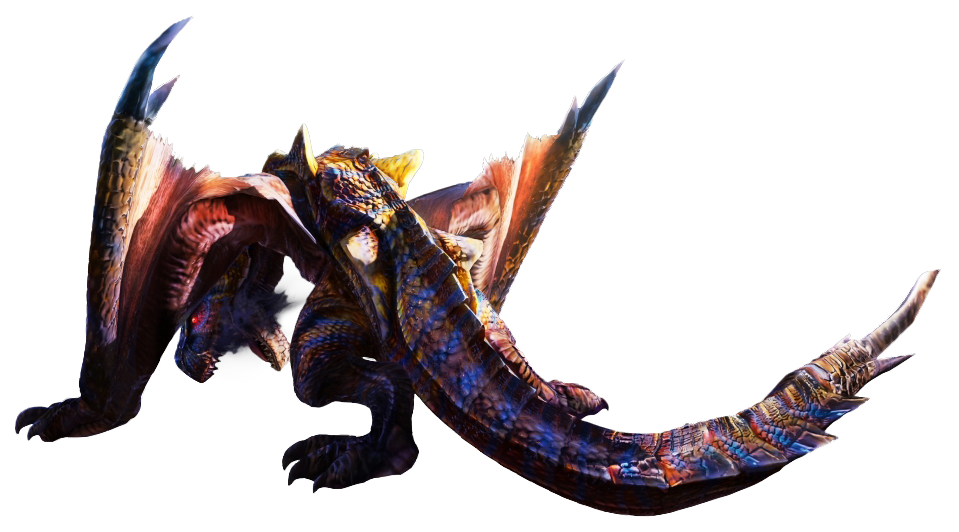
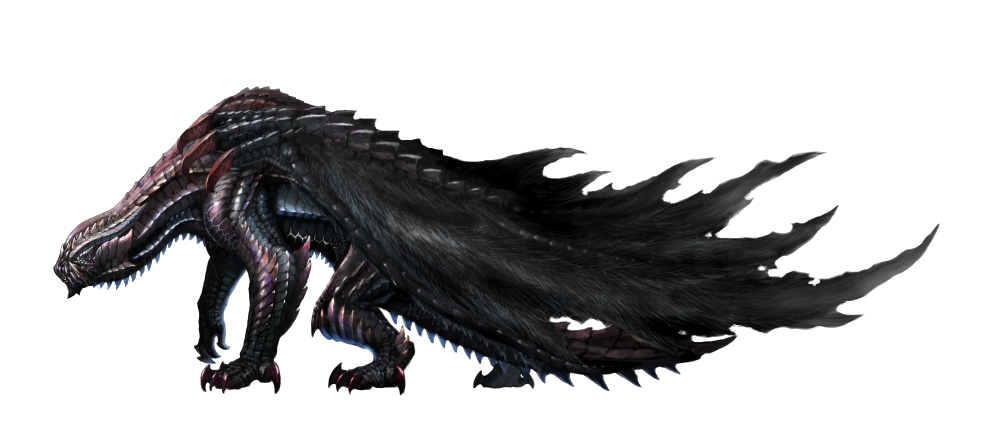
Gore Magala
Huge monstrosity (unknown), chaotic evil
- Armor Class 20 (natural armor)
- Hit Points 243 (18d12 + 126)
- Speed 40 ft., fly 80 ft.
STR DEX CON INT WIS CHA 27 (+8) 18 (+4) 25 (+7) 12 (+1) 15 (+2) 19 (+4)
- Saving Throws Str +15, Wis +9, Cha +11
- Skills Perception +9, Stealth +11
- Damage Immunities necrotic; bludgeoning, piercing, and slashing from nonmagical weapons
- Condition Immunities blind, charmed, frightened, stunned
- Senses Blindsight 120 ft., passive Perception 19
- Languages -
- Challenge 21 (33,000 xp)
Frenzy. When a creature has 3 Frenzy Charges, they must makes a DC 22 Constitution saving throw. On a fail, the target is afflicted with the Frenzy Virus until dispelled by a Greater Restoration spell. On a success, the frenzy charges reset to 0.
Legendary Resistance (3/Day). If the gore magala fails a saving throw, it can choose to succeed instead.
Actions
Multiattack. The gore magala makes three attacks, one with its bite and two with its claw.
Claw. Melee Weapon Attack: +15 to hit, reach 5 ft., one target. Hit 15 (2d6 + 8) slashing damage.
Bite. Melee Weapon Attack: +15 to hit, reach 10 ft., one target. Hit 21 (3d8 + 8) piercing damage and the target gains 1 frenzy charge.
Viral Discharge. range Weapon Attack: +11 to hit, reach 80/320 ft., one target. Hit 14 (4d6) necrotic damage and the target gains 1 frenzy charge.
Virus Wave (Recharge 5-6). The gore magala unleashes a necrotic pulse in a 30 foot radius around it. Each Creature in that area must make a DC 20 Dexterity saving throw, taking 63 (14d8) necrotic damage and gain 1 frenzy charge on a failed save. On a success, a target takes half the damage, and does not gain any frenzy charges.
Legendary Actions
The gore magala can take 3 legendary actions, choosing from the options below. Only one legendary action option can be used at a time and only at the end of another creatures turn. The gore magala regains spent legendary actions at the start of its turn.
Detect. The gore magala makes a Wisdom (Perception) Check.
Bad Breath. The gore magala makes a Viral Discharge attack.
Frenzy Dash (Costs 2 Actions). The gore magala moves up to its speed, during this move it may move through other creatures. Any creatures the gore magala moves through must succeed on a DC 21 Dexterity saving throw or take 18 (3d6 + 8) bludgeoning damage and be knocked prone.
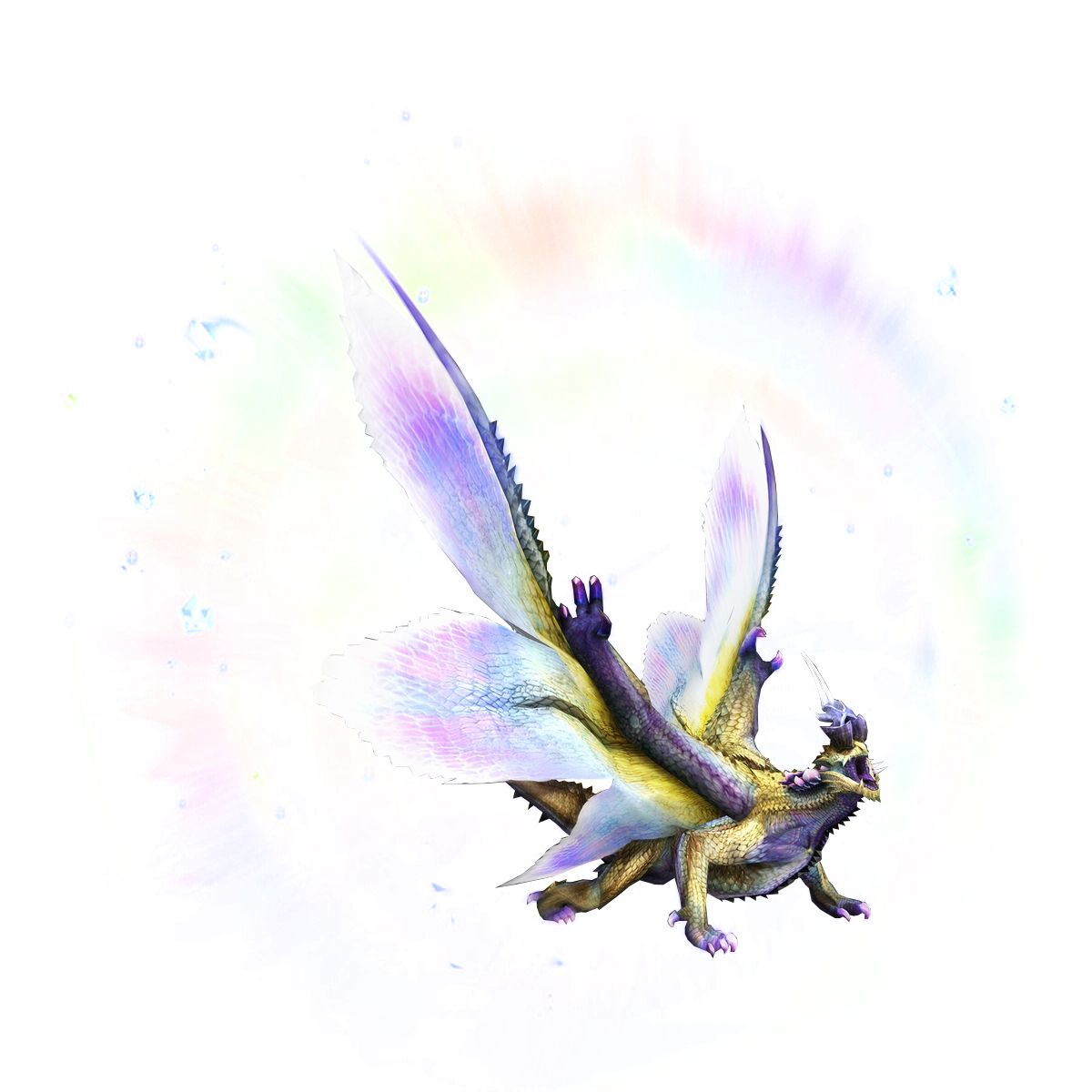
Shagaru Magala
Huge monstrosity (elder), chaotic evil
- Armor Class 21 (natural armor)
- Hit Points 377 (26d12 + 208)
- Speed 40 ft., fly 80 ft.
STR DEX CON INT WIS CHA 29 (+9) 20 (+5) 27 (+8) 15 (+2) 15 (+2) 20 (+5)
- Saving Throws Str +17, Wis +10, Cha +13
- Skills Perception +10
- Damage Immunities necrotic; bludgeoning, piercing, and slashing from nonmagical weapons
- Condition Immunities charmed, frightened, prone, stunned
- Senses Truesight 120 ft., passive Perception 20
- Languages -
- Challenge 25 (75,000 xp)
Frenzy. When a creature has 3 Frenzy Charges, they must makes a DC 24 Constitution saving throw. On a fail, the target is afflicted with the Frenzy Virus until dispelled by a Greater Restoration spell. On a success, the frenzy charges reset to 0.
Aggressive. As a bonus action, the shagaru magala can move up to its speed toward a hostile creature that it can see.
Legendary Resistance (3/Day). If the shagaru magala fails a saving throw, it can choose to succeed instead.
Actions
Multiattack. The shagaru magala makes four attacks, two with its bite and two with its Claws.
Claws. Melee Weapon Attack: +17 to hit, reach 5 ft., one target. Hit 19 (3d6 + 9) slashing damage.
Bite. Melee Weapon Attack: +17 to hit, reach 10 ft., one target. Hit 22 (3d8 + 9) piercing damage and the target gains 1 frenzy charge.
Viral Discharge. range Weapon Attack: +13 to hit, reach 80/320 ft., one target. Hit 22 (4d10) necrotic damage and the target gains 1 frenzy charge.
Virus Geysers (Recharge 5-6). The shagaru magala spreads spores in a large vortex around itself. It then launches itself 60 feet in the air creating multiple 5 foot spore geysers in a 60 foot radius around them. The shagaru magala may choose up to 3 creatures in the area that must make a DC 21 Dexterity saving throw, taking 63 (14d8) necrotic damage and gain 2 frenzy charge on a failed save. On a success, a target takes half the damage, and does not gain any frenzy charges.
Legendary Actions
The shagaru magala can take 3 legendary actions, choosing from the options below. Only one legendary action option can be used at a time and only at the end of another creatures turn. The shagaru magala regains spent legendary actions at the start of its turn.
Detect. The shagaru magala makes a Wisdom (Perception) Check.
Bad Breath. The shagaru magala makes a Viral Discharge attack.
Wing Attack (Costs 2 Actions). The shagaru magala beats its wings. Each creature within 15 feet of the shagaru magala must succeed on a DC 24 Dexterity saving throw or take 22 (3d8 + 9) bludgeoning damage and be knocked prone. The shagaru magala can then fly up to half its flying speed.
The Leshen
The Leshen's body structure or biology is completely alien to the known world. The creature stands upright on two limbs that support an eerily humanoid body made of what appears to be wood, which it covers with ragged clothing; branches grow out of its shoulders, which may have the remains of its most recent victims hanging upon them. The Leshen's head is an animal's skull, topped by a pair of antlers unlike anything seen in the Old or New World. The Leshen seemingly lacks any functioning eyes, mouth or any features expected from the head of a living monster. Indeed, in its own world it is thought to be a nature spirit rather than any kind of living creature.
The only features of Leshens that would make sense are its long pair of arms, which end in razor-sharp claws. While Leshens aren't nearly as fast or ferocious in close-quarter combat as many creatures of the known world, the Leshen's cunning mind and magic allows it to make effective use of its claws, often pulling deceptively slow maneuvers or using its teleportation to cut down unwary opponents from behind.
Geralt of Rivia, the Witcher who came from the same world as the Leshen noted that the creature has made itself more powerful than its average brethern in their home world by absorbing the rich nutrients of the New World.
Leshens are very territorial and will attack anything that they can not (or do not wish to) influence with their magic. It is said that that they are closely attuned to the forests in which they live, and will slay anyone who fails to treat the forests with respect. For this reason, legends in its homeworld claim that Leshens despise humans for destroying woodlands as they expand their settlements.
While not physically agile or strong in comparison to most creatures the Commission faced (even after absorbing rich nutrients from the New World), Leshens have powerful magical abilities that they can use to command nature itself.
Leshens can summon and control strangling roots from the ground and take control of the minds of lesser creatures. So far, Jagras, Gajalaka and Revolture are the only creatures that have proven vulnerable to a Leshen's mind control. They have also been observed to teleport, dissolving into a cloud of smoke which reforms elsewhere.
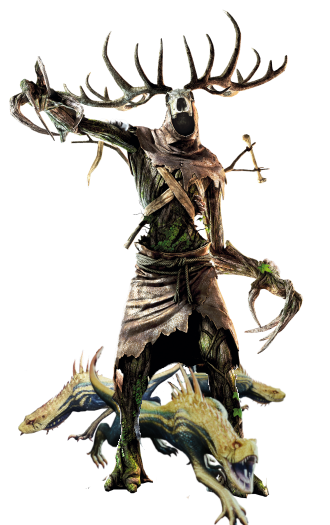
Leshen
Huge monstrosity (unknown), unaligned
- Armor Class 17 (natural armor)
- Hit Points 157 (15d12+60)
- Speed 25 ft.
STR DEX CON INT WIS CHA 19 (+4) 10 (+0) 18 (+4) 16 (+3) 14 (+2) 12 (+1)
- Saving Throws Str +8, Con +8, Cha +5
- Skills Animal handling +6, Nature +6, Perception +6
- Condition Immunities charmed, frightened, paralyzed, stunned, unconscious
- Senses darkvision 60 ft., passive Perception 16
- Languages -
- Challenge 12 (8,400 xp)
Aura of Crows. At the start of each of the leshen's turns, each creature within 5 feet of it takes 3 (1d6) piercing damage. A creature that touches the leshen or hits it with a melee attack while within 5 feet of it takes 3 (1d6) piercing damage.
Crows. The leshen has an infinite number of crows (using the Raven stat block). Should any die, the leshen conjures more at the start of its turn.
Fire Susceptibility. If the leshen takes fire damage, it suffers several effects until the end of its next turn: it cannot teleport, it can't use its Multiattack, and it only regains 2 legendary actions at the start of its turn.
Magic Weapons. The leshen's weapon attacks are magical and its ranged weapon attacks ignore cover.
Actions
Multiattack. The leshen uses its root strike and then makes two claw attack attacks. It can replace one of its claw attacks with its murder of crows attack.
Claws. Melee Weapon Attack. +8 to hit, reach 10 ft., one target. Hit 17 (3d8 + 4) slashing damage.
Root Strike. The leshen targets a creature that it can see within 90 feet of it. That creature must succeed on a DC 18 Dexterity or Strength saving throw, or they are pushed back 10 feet, knocked prone, and take 14 (4d6) piercing damage. On a successful save, the creature takes half as much damage and they are not knocked prone, but they are still pushed back 10 feet.
Murder of Crows. Range Weapon Attack. +8 to hit, reach 80/320 ft., one target. Hit 13 (2d8 + 4) piercing damage. If the creature is grappled or restrained, the crows continue to circle the target.
While they circle, the creature takes 3 (1d6) piercing damage at the start of its turn. The crows stop circling once the creature is no longer grappled or restrained.Entangling Roots. The ancient leshen chooses a creature on the ground that it can see within 120 feet of it. The target must succeed on a DC 18 Dexterity saving throw or be restrained by entangling roots. A creature restrained by the roots can use its action to make a DC 18 Strength check, freeing itself on a success.
Gnarled Growth (Recharge 5-6). The leshen releases a pulse of energy through the ground causing gnarled roots to explode outward in a 20-foot radius around it. Each creature in that area must make a DC 16 Dexterity saving throw, taking 35 (10d6) piercing damage on a failed saving throw, or half as much on a successful saving throw.
Legendary Actions
The leshen can take 3 legendary actions, choosing from the options below. Only one legendary action option can be used at a time and only at the end of another creatures turn. The leshen regains spent legendary actions at the start of its turn.
Attack. The leshen makes a claw or murder of crows attack.
Teleport. The leshen body, along with any equipment it is wearing or carrying, scatters into a few dozen crows and then reforms up to 60 feet to an unoccupied space it can see.
Imprison (Costs 2 Actions). The leshen uses its Entangling Roots.
Summon Jagras (Costs 3 Actions). The leshen calls 3 (1d6) jagras to its aid.
Reactions
Conjure Roots (Recharge 6). When an enemy creature ends its turn, the leshen can use its reaction to create a wall of roots from the ground around it. The wall forms in a circle that has a 15-foot diameter and is up to 20 feet high and 5 feet thick. The wall provides three-quarters cover.
When the wall appears, each creature within its area is pushed 5 feet away from the leshen. A creature cannot pass through the wall, but each 5 foot section of the wall can be attacked and destroyed. (AC 10; hp 30; vulnerability to fire damage; immunity to bludgeoning, poison, and psychic damage).
Ancient Leshen
Huge monstrosity (unknown), unaligned
- Armor Class 20 (natural armor)
- Hit Points 230 (20d12+100)
- Speed 25 ft.
STR DEX CON INT WIS CHA 21 (+5) 10 (+0) 20 (+5) 19 (+4) 16 (+3) 12 (+1)
- Saving Throws Str +12, Con +12, Wis +10, Cha +8
- Skills Animal handling +10, Insight +10, Nature +10, Perception +10
- Damage Resistances bludgeoning
- Condition Immunities charmed, frightened, paralyzed, stunned, unconscious
- Senses darkvision 60 ft., passive Perception 20
- Languages -
- Challenge 21 (33,000 xp)
Aura of Crows. At the start of each of the ancient leshen's turns, each creature within 10 feet of it takes 7 (2d6) piercing damage. A creature that touches the ancient leshen or hits it with a melee attack while within 10 feet of it takes 7 (2d6) piercing damage.
Crows. The ancient leshen has an infinite number of crows (using the Raven stat block). Should any die, the ancient leshen conjures more at the start of its turn.
Legendary Resistance (3/Day). If the ancient leshen fails a saving throw, it can choose to succeed instead.
Magic Resistance. The ancient leshen has advantage on saving throws against spells and other magical effects.
Magic Weapons. The ancient leshen's weapon attacks are magical and its ranged weapon attacks ignore cover.
Actions
Multiattack. The ancient leshen uses its root strike and then makes two claw attack attacks. It can replace one of its claw attacks with its murder of crows attack.
Claws. Melee Weapon Attack. +12 to hit, reach 10 ft., one target. Hit 18 (3d8 + 5) slashing damage. If the target is a creature other than an undead or a construct, it must succeed on a DC 20 Constitution saving throw or lose 5 (1d10) hit points at the start of each of its turns due to an bloody wound. Each time the ancient leshen hits the wounded target with this attack, the damage dealt by the wound increases by 5 (1d10). Any creature can take an action to stanch the wound with a successful DC 15 Wisdom (Medicine) check. The wound also closes if the target receives magical healing.
Root Strike. The ancient leshen targets two creatures that it can see within 90 feet of it. Each creature must succeed on a DC 20 Dexterity or Strength saving throw, or they are pushed back 10 feet, knocked prone, and take 14 (4d6) piercing damage. On a successful save, the creature takes half as much damage and they are not knocked prone, but they are still pushed back 10 feet.
Murder of Crows. Range Weapon Attack. +12 to hit, reach 80/150 ft., one target. Hit 14 (2d8 + 5) piercing damage. If the creature is grappled or restrained, the crows continue to circle the target.
While they circle, the creature takes 7 (2d6) piercing damage at the start of its turn. The crows stop circling once the creature is no longer grappled or restrained.Entangling Roots. The ancient leshen chooses a creature on the ground that it can see within 120 feet of it. The target must succeed on a DC 20 Dexterity saving throw or be restrained by entangling roots. A creature restrained by the roots can use its action to make a DC 20 Strength check, freeing itself on a success.
Gnarled Growth (Recharge 5-6). The ancient leshen releases a pulse of energy through the ground causing gnarled roots to explode outward in a 20-foot radius around it. Each creature in that area must make a DC 18 Dexterity saving throw, taking 63 (18d6) piercing damage on a failed saving throw, or half as much on a successful saving throw.
Scatter (3/day). The ancient leshen's body scatters into hundreds of crows in all directions. The leshen then attacks each creature within 80 feet of it, with its murder of crows attack. The leshen then reappears in an unoccupied location within 60 feet of its original location.
Legendary Actions
The leshen can take 3 legendary actions, choosing from the options below. Only one legendary action option can be used at a time and only at the end of another creatures turn. The ancient leshen regains spent legendary actions at the start of its turn.
Attack. The leshen makes a claw or murder of crows attack.
Teleport. The leshen body, along with any equipment it is wearing or carrying, scatters into a few dozen crows and then reforms up to 60 feet to an unoccupied space it can see.
Imprison (Costs 2 Actions). The ancient leshen uses its Entangling Roots.
Summon Shamos (Costs 3 Actions). The ancient leshen calls 3 (1d6) shamos to its aid.
Reactions
Conjure Roots (Recharge 6). When an enemy creature ends its turn, the ancient leshen can use its reaction to create a wall of roots from the ground around it. The wall forms in a circle that has a 15-foot diameter and is up to 20 feet high and 5 feet thick. The wall provides three-quarters cover.
When the wall appears, each creature within its area is pushed 5 feet away from the ancient leshen. A creature cannot pass through the wall, but each 5 foot section of the wall can be attacked and destroyed. (AC 15; hp 40; vulnerability to fire damage; immunity to bludgeoning, poison, and psychic damage).

Thank you
For
Checking this out
Thank you all for using this Monster hunter Monster Manual. I created a few monsters originally because I wanted to use them in my own campaign and progressed into this Monster Manual we have today.
This section is 22 pages of monsters from the series and I am pretty proud to say I created them. I hope you all enjoy using these creatures as much as I plan too and this is not the end.
The Monster Manual might be done, but thanks to a few ideas from users on Reddit. I plan on creating a compendium with loot tables for materials, all of the weapons from the videogame series, and rules for using these monsters in your own Monster Hunter D&D game.
If you are interested in letting me know what you think. Feel free to stop by my Twitch channel or check out my Patreon. Thank you for reading and I hope this book serves you well.
Art
Most art, except the cover art, has been gathered from https://monsterhunter.wikia.com website and edited if needed to fit the page. The few others are listed below.
Lore
Most Lore, about these monsters, was also gathered from https://monsterhunter.wikia.com and then edited to omit any mention of missing skills and make the lore more in line with a D&D setting.